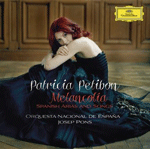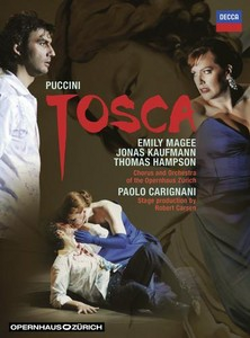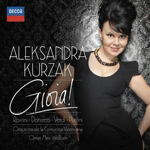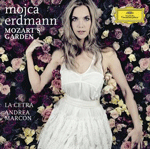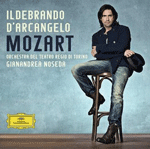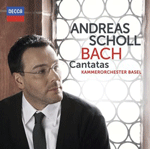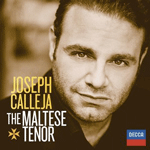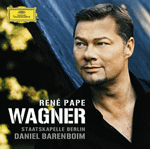November 28, 2011
François Couperin by Florilegium, Wigmore Hall
These qualities were affectingly demonstrated during this wonderfully tender performance by Florilegum of secular instrumental and sacred vocal music, compositions which unite the best of contemporary French and Italian conventions.
Couperin was born in 1688 in Paris, the son of Charles Couperin, the organist St Gervais in Paris. On his father’s premature death, the organist position passed to Lalande, but François, an early musical genius, was already deputising for Lalande at the age of ten, and on his 18th birthday he officially inherited his father’s previous position. Lalande praised the young man’s innovative 1690 collection of Pièces d’orgue as “worthy of being given to the public” and helped to establish him as a Court organist in 1693. In 1700 Couperin acquired the younger D’Anglebert’s position as harpsichordist at Versailles.
He amassed a notable quantity of superlative harpsichord pieces, which began appearing in elegantly engraved editions in 1713, following other noteworthy collections by Rameau and Dandrieu; but, ever the individualist, Couperin chose to group his pièces into ordres rather than suites, and relied much less on dance movements than his contemporaries, preferring the freer and more evocative pièces de caractère.
In his publications of the early 1720s he offered a wide variety of ways in which the French and Italian styles might be united. As Richard Langham Smith’s eloquent, informative programme notes state, the works grouped under the title of Les Nations were “written in the style of Corelli”; the composer had been “charmed by the sonatas of Corelli, whose works I shall love as long as I shall live, just as I do the works of Monsieur de Lully”.
Les Nations is the title under which Couperin published a collection of four large-scale sonatas; Florilegum presented two – the earliest of the ordres composed for chamber consort – La Françoise and L’Espagnole. Director Ashley Solomon, fellow traverse flautist Andrew Crawford, and violinists Bojan Cici and Tuomo Suni were expressively supported by Emilia Benjamin’s viola da gamba, David Miller’s theorbo and the delectable harpsichord playing of Terence Charistan. The ensemble relished Couperin’s luscious timbres and colours, responding naturally to the considerable rhetoric of the small dance forms, exploiting contrast and delighting in the piquant expressive dissonances.
In the slower, more intricate movements, as in the ‘Sarabande’ of L’Espagnole, the meticulous attention to ornament and detail was impressive, although such details were never allowed to disrupt the graceful melodic line. String and woodwind articulation in the more energetic dances was bracingly crisp and fresh; repetitions were constantly re-invigorated. Rapid passage work in ‘La Gigue’ from La Françoise was sharply articulated. Despite the fact that these interpretations were clearly honed to perfection, there was a surprising sense of spontaneity, as if the reading was unfolding in real time.
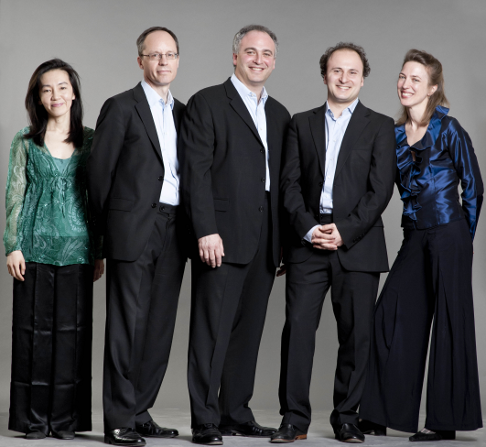 Florilegium [Photo by Amit Lennon]
Florilegium [Photo by Amit Lennon]
The instrumentalists were joined by sopranos Dame Emma Kirkby and Elin Manahan Thomas in Couperin’s captivating Leçons de Ténèbres, extremely beautiful and genuinely spiritual music for ecclesiastical use. Couperin’s interest in the Italian style, as represented by Carissimi and Charpentier, influenced his sacred vocal music, particularly his motets, versets and leçons de ténèbres, and the result of this stylistic diffusion is enchantingly presented in the Leçons.
In the Tenebrae service, psalms are sung, interspersed with the text from the Lamentations of Jeremiah. In Couperin’s setting we are aware of delicate and deliberate crafting: each of the responsaries is preceded by a huge musical ‘capital letter’ much like the way the first letter of a Hebrew psalm is set to a long melisma – as Langham Smith describes “a musical equivalent to an ornamented manuscript with elaborately gilded capital letters.”
The two soloists brought their own strengths to the delivery of the text. Thomas, alert and energised, using the voice to thrill and excite; Kirkby effortlessly shaped individual phrases into affecting larger units, creating heart-rending melodic shapes and inflecting the text with human sentiment. Soaring melodic arches and effortlessly gilded ornaments evoked cathedral realms. For Kirkby aficionados, vocal purity and beauty is taken for granted, but she also exhibited a real sense of the architectural splendour of these pieces.
Thomas’s pronunciation of the Latin text was idiomatically French in inflection, as it would have been performed at the time. Her ornamentation was superb; she produced a shimmering beauty which invigorated the sacred text with exotic nuance. In the third lesson, the intertwined soaring voices evoked aspiring gothic cathedral arches. The accompaniment was flexible and alert, sensitive to nuance and creating a real sense of intimacy. The repeated refrain, “Jerusalem, Jerusalem, convertere ad Dominium Deum tuum”, (Jerusalem, return thee to the Lord, thy God) both united the various lessons, and provided variety and gradation.
These are pieces of heavenly exquisiteness, designed to inspire piety through their sheer beauty. Whatever one’s religious allegiances and affiliations, this recital inspired ‘devotion’ through the performers’ absolute commitment to magnificent splendour and nuanced, expressive inflection, perfectly assimilating the sacred and the secular.
Claire Seymour
image=http://www.operatoday.com/Couperin.png image_description=François Couperin product=yes product_title=François Couperin: Sonata from Premier Ordre: La Françoise ‘Les Nations’; Première Leçon de ténèbres pour le mercredi Saint; Deuxième Leçon de ténèbres pour le mercredi Saint; Suite from Premier Ordre: La Françoise ‘Les Nations’; Sonata from Premier Ordre: L’Espagnole ’Les Nations’; Troisième Leçon de ténèbres pour le mercredi Saint; Suite from Premier Ordre: L’Espagnole ‘Les Nations’. product_by=Dame Emma Kirkby, soprano; Elin Manahan Thomas, soprano. Florilegium. Ashley Solomon. director. Wigmore Hall, London, Thursday 24 November, 2011. product_id=Above: François CouperinNovember 27, 2011
Tosca, ENO
Malfitano’s staging makes a refreshing change both from the likes of the floundering first-time spoken theatre and film directors often recently engaged by the company, and from the ludicrous, dramatically-null vulgarity of the Zeffirelli brigade. It doubtless helps to have someone at the directorial helm who knows the work from the inside, having sung the title-role a good many times herself. There is nothing here — with the possible exception of the third act — to frighten self-appointed ‘traditionalists’, although in such repertoire and with respect the audiences it tends to attract, I cannot help but wish that someone would occasionally shock the horses. (Just imagine what Calixto Bieito might make of Tosca!) Despite the sometimes bizarre specificity of the libretto, there seems to me no reason why intelligent relocation or abstraction could not work: the opera is not in any meaningful sense ‘about’ the experience of the French Revolution in Rome. Malfitano, however, elects successfully to retain the settings and for the most part the attitudes of the work’s creators, respecting as do they the classical unities.
The first act is therefore set in S.Andrea della Valle at noon, convincingly represented in realistic fashion by Frank Philipp Schlössmann’s designs. The force of Cavaradossi’s painting registers straightforwardly, but none the worse for that. One strongly feels the menace of the Church as pillar of the (re-)established order at the entrance of clergy and acolytes for the “Te Deum”. (I cannot help but find the anti-clericalism shallow, verging on the puerile, but that is no fault of the production.) Likewise, the second act is set at evening in Scarpia’s quarters in the Palazzo Farnese, furnished as one might expect, though without excess. The third act therefore comes as a bit of a surprise, at least in terms of designs . Doubtless taking as its cue references in words and stage directions to the stars, perhaps even those to the saints in heaven, we see the skies as if from a space ship, though something akin to the battlements is still present. It did not bother me in the slightest, though nor, by the same token, did I find the image revelatory. Throughout, Malfitano’s direction of the characters on stage proves quietly accomplished, providing neither mishaps nor particular flashes of revelation. I do not mean to imply that it is dull, for it is not, but nor does this in any sense approach reinterpretation, for which many will doubtless be relieved. If I found the final melodrama as difficult to take as ever, a not-entirely-fitting conclusion to so well-crafted a score, then clearly I am in the minority; rightly or wrongly, it receives faithful treatment here.
Stephen Lord’s conducting was impressive. Lord is not a conductor I have previously heard, but I should certainly be interested to do so again. Despite the occasional instance of perhaps driving the score a little hard, the full yet variegated sound conjured from the orchestra was as fine as I have heard at the Coliseum for quite some time. Alert to Puccini’s Wagnerisms without overplaying them, there was a fine continuity to Lord’s traversal of the score, which here in both harmony and orchestration at times sounded, to its great benefit, appreciably more modernistic than one often hears. It was not for nothing that both Schoenberg and Berg were admirers. Even Mahler, in his scathing description of a Meistermachwerk, acknowledged the skill of orchestration — an undoubted advance upon so many of Puccini’s Italian forebears — though added that any cobbler nowadays could merely ‘orchestrate to perfection’.
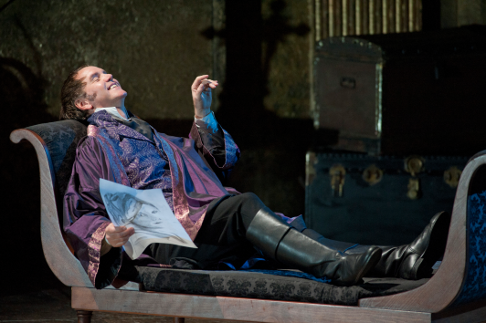 Anthony Michaels-Moore as Scarpia
Anthony Michaels-Moore as Scarpia
If the singing did not truly scaled the heights, it was professionally despatched. No one is going to replicate Callas, and Claire Rutter wisely did not attempt to try: hers was an intelligent enough stage portrayal, a little lacking in charisma perhaps, likewise in creation of the diva-status of Floria Tosca as singer, but, despite occasional weakness in sustaining her line, there was nothing grievous to worry about. Gwyn Hughes-Jones’s Cavaradossi was not entirely free of crooning tendencies, nor did it revel in subtleties, but it was well enough sung, and would doubtless have sounded better in Italian. Anthony Michaels-Moore seemed to experience vocal difficulties in the first act but his Scarpia sharpened up in the second, albeit without ever quite capturing the sheer danger and malevolence of the most notable interpreters. The smaller parts were all well taken. Choral singing, not always the strongest point recently at the Coliseum, was similarly accomplished.
Mark Berry
image=http://www.operatoday.com/Tosca_2011_Claire_Rutter_Gwyn_Hughes_Jones_4_Credit_Mike_Hoban.png image_description=Claire Rutter as Tosca and Gwyn Hughes Jones as Cavaradossi [Photo by Mike Hoban courtesy of English National Opera] product=yes product_title=Giacomo Puccini: Tosca product_by=Floria Tosca: Claire Rutter; Mario Cavaradossi: Gwyn Hughes Jones; Baron Scarpia: Anthony Michaels-Moore; Cesare Angelotti: Matthew Hargreaves; Sacristan: Henry Waddington; Spoletta: Scott Davies; Sciarrone: Graeme Danby; Gaoler: Christopher Ross; Shepherd-boy: Jacob Ramsay-Patel. Director: Catherine Malfitano; Set designs: Frank Schloessmann; Costumes: Gideon Davey; Lighting: David Martin Jacques and Kevin Sleep. Chorus of the English National Opera (chorus master: Nicholas Chalmers); Orchestra of the English National Opera; Stephen Lord (conductor). Coliseum, London, Saturday 26 November 2011. product_id=Above: Claire Rutter as Tosca and Gwyn Hughes Jones as CavaradossiiPhotos by Mike Hoban courtesy of English National Opera
Piotr Beczala
Richard Eyre’s production premiered in 1994 and has been revived many times. Indeed, there are three different runs this year alone, with three different casts. Two DVDs are available, one conducted by Georg Solti, and another released this year with Renée Fleming, Joseph Calleja and Thomas Hampson. It’s a hardy perennial. Must the role be daunting to take on?
Piotr Beczala flashes a brilliant smile. He loves this staging and is delighted to be taking part. “The winds of time are blowing away the good Zefferelli and Schenk productions. It’s a pity in my opinion, but you have to live with it”. So he’ll be singing with special pleasure because it’s a historic production. In the second act, Alfredo and Violetta are in the country house. “It’s so beautiful, the colours are lovely pastels, and the dimensions of the set put attention on the singers. Productions like this give the singers a chance to tell the story. It’s not just the directors”.
This is Beczala’s ninth Alfredo since 1993, so the part is close to his heart. So it’s an advantage that he’s coming to the Eyre staging he likes so much, for he will be singing with fresh enthusiasm. “There is no such thing as routine in this business”, he says, “We start every performance like it’s completely new. Every performance has new ideas because the singers and conductor are different”. Dynamic relationships change. “Of course it’s more or less the same, but every time the tension between performers is new. That is what we transport to the public even if they’ve seen the staging many times”.
“Absolutely”, he adds, “because the words I’m singing express something I feel at that very moment. We have to learn to be the character together with the other characters. Every Violetta is different, and you have to work with the person who is singing the part. So the connection on stage is unique, and we create an experience. We communicate to the public the beauty of the opera”.
“So even though we know every note, we have lots of time to prepare. So we talk and work out in rehearsal what kind of energy to use in each scene so we create a unique picture in each production”.
In one season in 2010, Beczala sang Roméo in three different productions of Gounod Roméo et Juliette. At the Staatsoper in Vienna, he sang with Anna Netrebko, at the Royal Opera House in London with Nino Machaidze and at the Met in New York with Hei-kyung Hong (replacing Angela Gheorghiu). “Twenty four or twenty five performances, but never the same. It gave me the chance to really develop the role in different ways and get it 'in my throat'".
“Alfredo is not as easy a role as people might think. Any student can skip the high C’s but the really important challenge is to show how Alfredo’s character is changing. At first he’s naïve, but in the final act, he’s mature and adult confronted by Violetta’s death. This production is moving because it’s so realistic. Blood on the pillows!”
“Alfredo is struggling not to be like his father. Young people need to break from family tradition and make their own mistakes and learn responsibility. Alfredo wants to save Violetta because he thinks that the power of his love can change things. But life is brutal, it never works out as simple as that. We were talking in rehearsal about why Violetta needed a big country house. Why not rent a smaller place so the money would last longer ? She’s not like Manon, who was rich but can live simply when she needs to. Maybe in the back of her mind, Violetta needs champagne and caviar”.
Beczala looks amazingly young, even close-up, a great advantage for a singer who specializes in lyric Romantic heroes. But he greatly reveres the heritage of the past. He recalls wearing a costume which had been used by Nicolai Gedda. “It was very special, like the ghost of the past passing on energy”
“All my heroes are in the past”, he adds, “like Fritz Wunderlich, or Jussi Björling”. Beczala is a friend of Eva Wunderlich. “We talk about him a lot. I do a lot of the same repertoire that he did, like Tamino and Belmonte”.
“I was listening to Tito Schipa yesterday, singing the Siciliano from Cavalleria rusticana from 1913. It’s amazing how beautifully he sings. He used his voice intelligently. Singers like he and Caruso had to create the personality, the phrasing. No models. It’s good that we have so many wonderful recordings, but it’s also a handicap because we also have to create. Technique is always changing. Caruso was the first who sang with versimo fire “ but he didn’t overdo it. Too much verismich is histrionics, not real emotions and real singing”.
Beczala beams happily. “One of my dreams is to take my colleagues from today back to, say, 1907, to a studio and sing arias with very old microphones. Nowadays there is so much pressure from the media to create ’stars’, but I’m more interested in creating the characters through music”.
Anne Ozorio
image=http://www.operatoday.com/beczala_3.png
image_description=Piotr Beczala [Photo by Kurt Pinter]
product=yes
product_title=Piotr Beczala — An Interview
product_by=By Anne Ozorio
product_id=Above: Piotr Beczala [Photo by Kurt Pinter]
November 25, 2011
Saul, Barbican Hall
Charles Jennens compilation, based on biblical sources, created a powerful structure which enabled Handel to create a work which became the first of his English music dramas. The work was performed at the Barbican on Tuesday 21st November by The Sixteen under conductor Harry Christophers, in a concert performance which brought out the essential drama of the piece.
The title role is a remarkable portrait of a conflicted personality, and Handel emphasised this by reducing the characters arias and concentrating on recitative (both secco and accompanied). This means that it can be tricky role to bring off, fatally easy to under play in a concert performance. Peter Purves brought both Handelian bravura and drama to the role, no only acting but reacting, his performance continuing when others were performing, so that Purves showed Saul’s furious reaction to the Israelites praise for David. Purves is perhaps not the tidiest Handelian singer and he did have a tendency to distort the vocal line for expressive purposes. But this was a performance where music and drama went grippingly hand in hand.
The role of David was written for a woman to sing, but in recent years there has been a tendency for it to be sung by counter-tenors. Sarah Connolly demonstrated that in the right hands, the richness, depth and flexibility of a female mezzo-soprano voice can work wonders in the role. Though known for her Handel roles, Connolly’s voice has developed into quite a big instrument. Here she gave a finely moulded, intelligent performance of great beauty.
Robert Murray made an affable Jonathan, with a nicely turned phrase but not quite the purity of line that I would have liked. More importantly, I didn’t feel that there was much drama in the relationship between Murray’s Jonathan and Connolly’s David, though Murray’s individual contributions were finely done.
The drama isn’t perfect, Jennens libretto spends a little too much time on Saul’s daughters Merab and Michal. Elizabeth Atherton as Merab didn’t display quite such a firm line as I would have liked; but the role is a gift for an actress and Atherton displayed a nice line in temperament as the haughty Merab. Joelle Harvey was sweet as Michal, but the role doesn’t really call for much more. Harvey and Connolly duetted delightfully, but even they couldn’t quite convince that two duets in Act 2 is one duet too many.
But Act 2 closed in dramatic fashion with Purves’s powerful delivery of Saul’s accompagnato and a strong closing chorus, ‘O fatal consequence’. The drama continued to be vividly played in the final act, with Christophers encouraging the orchestra to bring out the rawness of Handel’s wonderful scene with the Witch of Endor. All closing with a strongly felt final Elegy.
The smaller roles (of which there are quite a few) were all taken by members of the Sixteen choir, with Jeremy Budd as an edgy, mysterious Witch of Endor, Mark Dobell as the High Priest, Stuart Young as an eerie Ghost of Samuel, Ben Davies as Does, Eamonn Dougan as a strongly characterised Abner and Tom Raskin as the unfortunate Amelkite killed by David at the end. All were strong and more than a credit to the group. Dobell did not always manage to make the rather prosy part of the High Priest interesting, but he was certainly had a good go.
The work was not strictly staged, and everyone sang from scores, but some thought had been put into elements of staging, entrances and exits so that the results contributed immensely to the feeling of drama. Though we had the libretto, diction was uniformly excellent and you hardly needed the words.
The 18 person choir (male altos, female sopranos) brought conviction and enthusiasm to their usually polished delivery. The chorus is called on to sometimes embody the Israelite people and sometimes simply comment; in whichever role the Sixteen was dramatically involved.
Handel’s orchestra is quite a large one, he uses trumpets, trombones and kettledrums. The work has a number of symphonies, describing off-stage action such as battles and funeral corteges so that Handel gives the orchestra a number of solo moments, with some lovely playing from harpist Frances Kelly; Handel also used a Carillon/Glockenspiel to great effect. The Sixteen Orchestra was clearly enthused by the work and by Christophers direction as they played with infection conviction. Christophers went for a rather rich continuo sound, using harp, theorbo, harpsichord and organ as part of the continuo group, which is understandable given the breadth of Handel’s orchestration in the piece. It was performed in Anthony Hicks’s edition.
Christophers ran each act without breaks, so that we had chance to feel how the drama flowed. He encouraged both cast and orchestra to produce vividly dramatic performances and the results were immensely engaging. There is a recording coming out next year and I look forward to it.
Robert Hugill
image=http://www.operatoday.com/Handel_NPG_mw02875.gif image_description=George Frideric Handel by Francis Kyte (1742) [Courtesy of National Portrait Gallery] product=yes product_title=G. F. Handel: Saul product_by=David: Sarah Connolly; Saul: Christopher Purves; Jonathan: Robert Murray; Merab: Elizabeth Atherton; Michal: Joelle Harvey; Witch of Endor: Jeremy Budd; High Priest: Mark Dobell; Ghost of Samuel: Stuart Young; Doeg: Ben Davies; Abner: Eamonn Dougan; Amalekite: Tom Raskin. The Sixteen Choir and Orchestra. Conductor: Harry Christophers. Barbican Hall, London, Tuesday, 22nd November 2011. product_id=Above: George Frideric Handel by Francis Kyte (1742) [Courtesy of National Portrait Gallery]Xerxes in San Francisco
It was a fine evening in the War Memorial Opera House, a rare visit by one of opera’s greatest dramatists, G.F. Handel now 326 years-old. San Francisco Opera welcomed his 273 years-old Xerxes with a production that is 26 years-old.
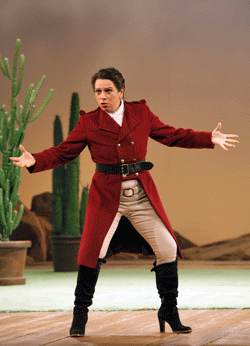 Sonia Prina as Amastris
Sonia Prina as Amastris
While the mushy acoustic of San Francisco’s venerable opera house is not kind to the linear detail and sculptural shapes of Baroque opera an exemplary cast overcame this handicap with the help of the English National Opera production directed by Nicholas Hytner and designed by David Fielding — purely and simply a classic.
The Handel revival has been going on quite a while now, in fact nearly one hundred years though not so many of his operas find their way onto the big stages to play for broader audiences. That may be the reason that when the populist and always lively ENO took on Xerxes for the Handel 1985 anniversary it choose to play up the comic elements of this opera seria, in fact to make it an outright comedy, trappings it wears quite naturally.
Impeccable comic timing and deadpan humor rarely describe performances by mezzo-soprano Susan Graham (whose roles at SFO include Iphigénie, Ariodante and Sister Helen [Dead Man Walking]). As the Persian king Serse (Xerxes) these attributes are as appropriate as the more usual phrases like impeccable musicianship and superb delivery. Her trouser acting technique does not attempt masculinity leaving us gratefully unconfused in the usual gender confusion.
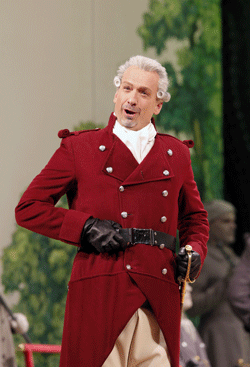 Wayne Tigges as Ariodates
Wayne Tigges as Ariodates
Almost the same things can be said about countertenor David Daniels who was her/his (Serse’s) rival in love, though in the case of Mr. Daniels the gender confusion became a part of the comedy with his maleness exaggerated by the addition of a beard — all the while singing in a male voice in a female register. Mr. Daniels has a quite beautiful falsetto that is evenly colored throughout his range, and exposes his mastery of Baroque style with every note.
To a man all the other pro- and antagonists were scene stealers. Heidi Stober and Lisette Oropesa were the sisters, Atalanta and Romilda, very lyric singers and beguiling actresses, complemented by the delightfully outraged Sonia Prina as Serse’s forgotten fiance Amastris, now disguised as a soldier. She earned a huge ovation for her dynamite, end of first act explosion “Saprà delle mie offese, ben vendicarsi il cor.”
Well, to a man it was hopeless, tormented love finally resolved by the dumb coyness of lovesick Serse aided by the very real charm of the servant Elviro sung by baritone Michael Samuel and by the pomposity of the general Ariodates adroitly served up by bass Wayne Tigges.
The greatest pleasure of the evening was however the finished staging accomplished by stage director Michael Walling. Its imposed precise movements were confidently executed by the cast. This finish alone allowed the comedy to shine as well as to expose gracefully the considerable personal charms of the seven principals. Not to mention the huge presence of 24 choristers (but only two brief choruses) and 17 tireless supernumeraries as the very slightly defined Persian society (disguised in period European dress) — totally gray, shadowy, barely visible gentle commentators on the shenanigans of Handel’s brightly dressed lovers — that added very welcome action and context to the countless arias.
David Fielding’s set on which Serse and Ariodates plot their invasion of Europe was a Baroque room with a garden superimposed (recognizing that Xerxes is really a pastorale) with a back wall that flew out to reveal some witty Middle Eastern vistas and side panels that opened to admit some monumental Persian sculpture in museum cases. Together with the cheap lawn chairs and newspapers there was plenty of nifty confusion of time and place to complement the amusing gender confusions mixed up in the silly romantic convolutions.
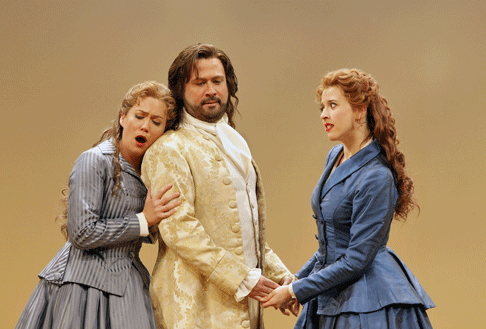 Lisette Oropesa as Romilda, Michael Sumuel as Elviro and David Daniels as Arsamenes
Lisette Oropesa as Romilda, Michael Sumuel as Elviro and David Daniels as Arsamenes
Conductor Patrick Summers allowed all this to happen without imposing musical extravagances, choosing instead to indulge in his sympathy for the needs of his singers. There was no real attempt or for that matter possibility or even need to create a Baroque sound in the vast expanse of the War memorial.
This production from twenty-six years ago reflects the tastes and challenges of that time, a particularly innovative period at the ENO. A new production now of this problematic opera might attempt to underscore the depth of emotion in its exposition of these tragic (genuinely unhappy) stories. The feelings are musically quite real. The heady humor of the Hytner production kept us outside and above the much of the potential musical depth and maybe some of the pleasures of this Handel score.
Michael Milenski
image=http://www.operatoday.com/Daniels_Graham_Xerxes.gif image_description=David Daniels as Arsamenes and Susan Graham as Xerxes [Photo by Cory Weaver courtesy of San Francisco Opera] product=yes product_title=G. F. Handel: Xerxes product_by=Xerxes: Susan Graham; Romilda: Lisette Oropesa; Arsamenes: David Daniels; Atalanta: Heidi Stober; Amastris: Sonia Prina; Ariodates: Wayne Tigges; Elviro: Michael Sumuel. San Francisco Opera Chorus and Orchestra. Conductor: Patrick Summers; Production: Nicholas Hytner; Revival Director: Michael Walling; Production Designer: David Fielding; Lighting Designer: Paul Pyant. (11/16/2011) product_id=Above: David Daniels as Arsamenes and Susan Graham as XerxesPhotos by Cory Weaver courtesy of San Francisco Opera
November 23, 2011
The Queen of Spades, Opera North
The experience marked me for life. I have never doubted since that Wozzeck is one of the greatest operas ever written, nor have I doubted that opera, whatever the disappointments one may experience in practice, can at its best prove at least as potent a form of drama as any other. It is many years now since I heard a performance from the company, though I have received very good reports from those who have, often comparing its offerings favourably with those on offer from the two principal London houses. I was therefore delighted to have opportunity to see and to hear for myself in Opera North’s first visit to the Barbican Theatre. (More are planned.) The timing was interesting too, affording comparison with Eugene Onegin across town at the Coliseum. Claire Seymour, writing for this site, enjoyed Deborah Warner’s staging much more than I did (click here).
First impressions of Neil Bartlett’s production were preferable to those of Warner’s Met-bound anodyne crowd-pleaser. There is, at least to begin with, no evident point of view expressed; straightforward storytelling seems the order of the day. By the same token, however, that does not come across as a deliberate policy to play safe, even to condescend. The setting is where it ‘should’ be; costumes are of the period; there is neither jarring nor particular elucidation. It would have been bizarre and not just unwelcome if the audience had followed the practice of a segment of that for Onegin and had drowned out the music by applauding Kandis Cook’s serviceable sets; they simply did their job without ostentation and without sentimental emphasis upon petit bourgeois conceptions of the ‘beautiful’. However, I said ‘first impressions’ above, because there is one aspect of Bartlett’s staging that might distress the literal-minded. It seemed interesting to me, yet arguably out of place in a production that offered nothing more of the same, rather as if the concept had wandered in from elsewhere. I speak of Bartlett’s treatment of the Countess, who emerges a sex-crazed vamp: she certainly would have captured attention in her scarlet gown even if she had not been played by Dame Josephine Barstow. Fitting or not, it was at least an idea, which was more than could be said for anything Warner mustered. The Personenregie, however, was considerably less skilled, or at least its execution was. And If Catherine the Great made her appearance, I am afraid I missed it.
The real problems, though, lay in the musical performances, and above all with Jeffrey Lloyd-Roberts’s Hermann. It did not sound as though this were an off-day, more a matter of having taken on a task that lay far beyond what the voice was incapable of delivering. It would be a matter of taste rather than judgement whether the shouting or tuning proved more painful. This, I am sad to say, constituted some of the most troubling professional singing I have heard; indeed, most student or other amateur performances are executed at a much higher level. He improved slightly during the third act, though he continued to croon in a manner that might have been thought excessive for a West End musical. Some smaller roles were no less approximate and crude, though, by the same token, some proved much better. William Dazeley’s Yeletsky impressed, as did the Tomsky of Jonathan Summers. Perhaps best of all was Alexandra Sherman’s Pauline. Hers was that rare thing: a true contralto. Moreover, she could use it to properly dramatic ends, the song, ‘Podrugi milïye,’ musically shaped and genuinely moving. Orla Boylan’s Lisa had its moments, but sometimes found herself all over the place in terms both of (melo-)drama and of intonation.
The chorus had clearly been well trained by Timothy Burke, and generally acquitted itself well, most of all in the third act, when, despite the translation, choral sound came across as more plausibly Russian than elsewhere. (The translation itself veered between embarrassing couplets and the merely prosaic; in that respect, Martin Pickard’s work recalled what we heard from him for Onegin.) Barstow, as the reader may have guessed, stole the show. Though her tuning was a little awry upon her entrance, and some might have queried the preponderance of quasi-spoken, parlando style, she can still hold a stage. One longed for more, wishing that her palpable commitment had rubbed off on others.
Richard Farnes proved intermittently impressive. There was certainly dramatic drive, sensitivity too, to his conducting. Yet, whilst there were moments in which the orchestra sounded to have just the right Tchaikovsky sound - the opening of the third act, for instance - there were other passages in which the score veered awkwardly between dark, would-be Wagnerism and soft-centred Puccini. A greater body of strings would have assisted: though what was mustered played well, the lack of heft was apparent throughout. Characterful woodwind was offset by variable brass, sometimes blaring, sometimes surprisingly tentative. (Placing outside the pit, at the edge of the stage, doubtless did not help.)
It was just about worth it for the Countess, then, but Opera North’s outing to London proved for the most part a damp squib. And it is surely a little too easy to say that the problem may have lain in staging so ambitious a work. After all, it was Wozzeck, no less, that made such an impression upon me in Sheffield. The stage director of that searing, life-changing Wozzeck? Ironically, one Deborah Warner…
Mark Berry
Click here for a photo gallery and other production information.
image=http://www.operatoday.com/Tchaikovsky_portrait.png image_description=Pyotr Ilyich Tchaikovsky by Nikolay Kuznetsov [Source: Wikipedia] product=yes product_title=Pyotr Ilyich Tchaikovsky: The Queen of Spades, op.68 product_by=Lisa: Orla Boylan; Countess: Dame Josephine Barstow; Hermann: Jeffrey Lloyd-Roberts; Count Tomsky, Pluto: Jonathan Summers; Prince Yeletsky: William Dazeley; Pauline, Daphnis: Alexandra Sherman; Governess: Fiona Kimm; Chekalinsky: Daniel Norman; Sourin: Julian Tovey; Masha: Gillene Herbert; Chaplitsky: David Llewellyn; Narumov: Dean Robinson; Master of Ceremonies: Paul Rendall; Chloë: Miranda Bevin. Director: Neil Bartlett (director). Designs: Kandis Cook. Lighting: Chris Davey. Choreography: Leah Hausman. Chorus of Opera North (chorus master: Timothy Burke). Orchestra of Opera North. Richard Farnes (conductor). Barbican Theatre, London, Tuesday, 22 November 2011. product_id=Above: Pyotr Ilyich Tchaikovsky by Nikolay Kuznetsov [Source: Wikipedia]November 22, 2011
Hugh the Drover Over the Pub
The Rocky element may seem the least likely, but in fact Hugh the Drover grew out of Vaughan Williams’s wish “to set a prize fight to music.” One possibility he considered was an opera based on George Borrow’s strange, atmospheric Bildungsroman, Lavengro (1851), which contains what used to be one of the most famous fights in English literature. Such an opera may have had the dramatic profundity to establish a place in the English repertoire, but unfortunately it was never written. Instead, Vaughan Williams set a rather trite libretto by Harold Child (1869-1945), a writer and theatre critic with no previous experience of writing librettos. Child arranged a story (suggested in good part by the composer) in which there is a prize fight between love rivals. There is evidence that Vaughan Williams was unhappy with Child’s unrealistic rendering of country life, and his thoughts about his librettist’s talents are succinctly revealed in his immediate conversion to the idea of Literaturoper (his next opera, Sir John in Love, takes a libretto directly from Shakespeare no less). In 1942 he pointedly omitted Hugh from a list of his operas with “good libretti.”
Nevertheless, Child’s libretto is not quite the hopeless thing it is sometimes represented as. It tells a simple story of love-at-first-sight set in a Cotswold market town (inspired by Northleach, Gloucestershire) at the time of the Napoleonic wars. Mary, daughter of the village constable, is being pressed into an unwilling marriage with the wealthy but brutal John the butcher. When Hugh the drover appears and offers her the chance to escape to a life of heavily romanticised wandering she unhesitatingly declares a willingness to become his bride. Immediately afterwards John offers to fight anyone for twenty pounds, Hugh takes him on, says he is fighting for Mary, and in proper Rocky fashion comes from behind to win triumphantly. But then John denounces Hugh as a French spy, the villagers turn on him (a slight pre-echo of Peter Grimes), and he is placed in the stocks. Mary is loyal to her man, and when his innocence is proved they set off almost immediately to follow the droving life together. The main idea may have come from J. M. Synge’s first play, In the Shadow of the Glen (1903), where an unnamed tramp persuades an unhappily married woman to embark on some romanticised tramping with him (“you'll be hearing the herons crying out over the black lakes”).
Vaughan Williams set Hugh and Mary’s story to the most gloriously tuneful music possible. Hugh the Drover has the same sort of melodic richness as Cavalleria Rusticana, and as with Mascagni’s masterpiece much of it appears to be constructed from the very stuff of popular song. The analogy can be taken further, too: both these operas of high passions in country places have an unpretentious, spontaneous, youthful freshness about them (though Vaughan Williams was no youth when he wrote Hugh); and both include extensive choral music to construct a musical portrait of a community, the values of which have a significant bearing on the foregrounded action. What is most surprising, though, is that Vaughan Williams wrote some passionate, thrilling vocal lines for Hugh and Mary that would by no means be out of place in Cavalleria.
But while Mascagni’s opera conquered the world and came to define the very idea of “popular opera,” Hugh the Drover signally failed. Written between 1910 and 1914, no production could be arranged before the First World War erupted. After the war Vaughan Williams tinkered with it, and for unexplained reasons there was no production until 1924, when the British National Opera Company gave three performances at the end of their season. Since then there have been a considerable number of productions, nearly all of them in Britain, but it has been shunned by the big companies and come nowhere near to being a standard repertoire work.
It would be unfair to blame this wholly on the libretto. Hugh the Drover gives out mixed messages about what it wants to be, unlike Ethel Smyth’s closely contemporary The Boatswain’s Mate (1916), which similarly set out to be a “popular opera” and enjoyed vastly more success (it was in the repertory of the Old Vic in the 1920s). The Boatswain’s Mate, too, is a story of country life with music that often seems close to popular song. But Smyth, who prepared her own libretto, created far more believable characters and even when they sing in an obviously “operatic” fashion the dramatic illusion is maintained that they are ordinary people inhabiting their ordinary culture (just as in Albert Herring, say). By contrast, Hugh and Mary are not remotely credible as real country folk and their vision of marriage is purely fantastical. They are operatic lovers, as much Italian as British, and in their passion seem to enter a world of “high” culture remote from the popular culture of the village around them.
Should Hugh the Drover, then, be produced as a folksy village piece, or as a stirring, “operatic” love story, a sort of English verismo? Uncertainty has been fatal to the opera’s success. Big companies have no doubt correctly concluded that serious productions emphasising the more operatic qualities would get a thorough mauling from the professional critics (whose taste for British opera seldom ventures back further than Britten). The thinness of the story, the lack of psychological interest, and the clunky poetry of the libretto, too often unintentionally funny, would all be exposed. On the other hand, the size of the opera, and the musical demands it makes, have been major discouragements to the amateur and semi-professional companies who might be attracted to its more folksy, fun-filled side, and who could give it the sort of down to earth treatment as unpretentious entertainment that the story is best designed to support.
It would perhaps be a slight exaggeration to suggest that all the problems surrounding Hugh the Drover have been solved at a stroke by Hampstead Garden Opera, but it is close to the truth. Their production feels absolutely right. It has been made possible by a new reduced version of the score for chamber orchestra prepared by Oliver-John Ruthven; it’s pleasing to note that this was undertaken “with permission, encouragement and generous support from the Vaughan Williams Charitable Trust” and is now available to hire. At the small Upstairs at the Gatehouse theatre the musicians are unobtrusively tucked away to one side of the performance space, the rest of which is transformed into a Georgian town square. The audience is essentially in the imagined town, which comes across as the sort of charming vision of English country life in yesteryear in which we all like to believe. The theatre itself is famously above a pub, drinks can be taken upstairs, hardly anyone bothers to dress up, and the simplicity of it all is perfectly suited to the imagined world of Hugh the Drover, which could easily appear absurdly quaint framed by an elaborate proscenium arch.
The secret of Hampstead Garden Opera’s success, I think, is that they concentrate simply on the entertainment value of the opera. They neither attempt to dignify it with a serious treatment, nor trace some meaning in it that simply isn’t there, nor, heaven forbid, try to make it “relevant.” They do not send it up, but they “sub-reference” the audience, to use Charles Lamb’s term, just enough to say “look, this is all tremendous fun, and we’re really enjoying ourselves.” This palpable sense of enjoyment conveyed by the singers, combined with the sheer immediacy of the production, was tremendously infectious, and it is hard to imagine anyone with a taste for musical theatre, of whatever stamp, not enjoying this production. Indeed for anyone who’s “afraid of opera” but likes other kinds of musical theatre, this Hugh the Drover can be recommended as an irresistible introduction to the art form. Peter Grimes can wait till later.
The openness of the production to the pure pleasure of the work was not at the expense of any significant compromise in musical values. Zachary Devin and Phillipa Murray were superb as Hugh and Mary, both singing in the strong, impassioned but unshowy way that Vaughan Williams would have wanted. The supporting roles were sung in character very ably, and the chorus sang their socks off whenever they had the chance. Oliver-John Ruthven conducted himself, providing a spirited and faultless accompaniment to the proceedings; some subtleties in the full score were doubtless sacrificed in the rearrangement, but I can’t say I noticed, and I doubt anyone else did either.
Altogether, while I can imagine technically more polished versions of Hugh the Drover, I find it hard to imagine a better one, and now that it has been adjusted to the needs of smaller companies and venues I hope it will become more widely recognised for what it is: not a great opera, but great operatic entertainment, with melodies that lodge themselves in your head for days.
David Chandler
image=http://www.operatoday.com/Hugh_Drover_2627.gif image_description=Philippa Murray as Mary and Zachary Devin as Hugh the Drover [Photo by Laurent Compagnon courtesy of Hampstead Garden Opera] product=yes product_title=Ralph Vaughan Williams: Hugh the Drover product_by=Hugh the Drover: Zachary Devin; Mary: Phillipa Murray; John the Butcher: David Roberts; Aunt Jane: Charlotte King; The Showman / Sergeant: James Williams; The Constable: Ian Helm; The Turnkey: Nick Whitfield; The Ballad Seller: Robert Davis. Hampstead Garden Opera and the Dionysus Ensemble. Music Director / Conductor: Oliver-John Ruthven. Production Director: Angela Hardcastle. Set and Costume Designer: Charlie Tymms. Upstairs at the Gatehouse, Highgate, London, 12 November 2011 (matinee). product_id=Above: Philippa Murray as Mary and Zachary Devin as Hugh the Drover [Photo by Laurent Compagnon courtesy of Hampstead Garden Opera]
November 20, 2011
Turandot in San Francisco
Well, almost a new cast. The slave girl Liu of Leah Crocetto was a hold over from the October cast though her performance in these new circumstances seemed more vibrant and vivid. No longer dwarfed by larger than life colleagues, it was far bigger than before and this time it truly mesmerized the opera house — her prayer and supplication, then her suicide came in limpid pianissimi, in rich forti, the youth and freshness of her voice embodied the purity and innocence of maidenhood.
Susan Foster was both the new Turandot and a new Turandot — not the icy, unattainable princess but the vulnerable, neurotic maiden, a Turandot very rarely revealed. Now she was a human scaled, twisted rival of the pure and gentle Liu. To be sure Mme. Foster could not be the icy Turandot if she wanted to. She does not possess the steely, dramatic voice nor the mythic persona to engage in a shouting match with her suitor Calaf. But she does have an engaging dramatic voice with volume aplenty when she needs it, and a personal softness that shone beautifully in her touching revelation that Calaf’s name was in fact “love.”
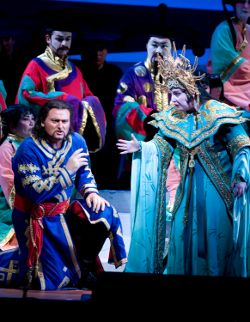 Walter Fraccaro as Calaf and Susan Foster as Turandot
Walter Fraccaro as Calaf and Susan Foster as Turandot
Calaf too, tenor Walter Fraccaro, had a softness and vulnerability that brought a very human dimension to his “Nessun dorma” that beguiled the opera house with its intimacy and earned him one of its all time biggest ovations. His Calaf was a young warrior who was perhaps as neurotic as Turandot, both of them equating love, or let us just say sex — there is that kiss — with death. Mr. Fraccaro did have the heft and volume in secure, supple voice to assault Turandot in his second act answers to her riddles.
Bass Christian Van Horn brought physical stature (he’s tall) and volume to Timur, confidently anchoring the narrative relationships of the opera’s’ protagonists. The Hockney production does not offer this personage opportunity to expand emotionally.
San Francisco Opera Resident Conductor Giuseppi Finzi allowed Puccini’s score to rise naturally from the pit, with tempos that encouraged its huge sonic scope to saturate the War Memorial Opera house. It is a great big opera that gives the San Francisco Opera chorus and orchestra opportunity to strut their stuff as two of the world’s fine ensembles.
The musical flow revealed this young conductor’s understanding of Puccini’s story. He did not sacrifice this newly discovered delicate humanity to dramatic and musical effect — this score’s fatal temptation. But what the young maestro could not do was drive the Alfano duet that ends the opera to the musical coherency that his predecessor Nicola Luisotti miraculously achieved, nor bring point and edge to the machinations of Ping, Pang and Pong.
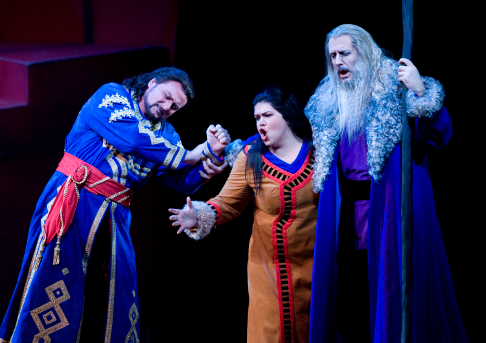 Walter Fraccaro as Calaf, Leah Crocetto as Liù and Christian Van Horn as Timur
Walter Fraccaro as Calaf, Leah Crocetto as Liù and Christian Van Horn as Timur
The Hockney production is saturated with Chinese reds and fantastical shapes that evoke much more than illustrate a sense of Oriental splendor. Hockney thinks two dimensionally, i.e. the proscenium opening is a canvas, thus we are presented with a succession of paintings. This places his characters on the canvas, or rather it freezes them onto the canvas. There is little movement, and virtually no dramatic reality, i.e. characters do not speak to each other — conversations are a visual, public presentation. Puccini’s Turandot offered this formidable visual artist unique opportunity to create a masterpiece.
Michael Milenski
image=http://www.operatoday.com/turandot003.png
image_description=Susan Foster as Turandot [Photo by D. Ross Cameron/San Francisco Opera]
product=yes
product_title=Giacomo Puccini: Turandot
product_by=Turandot: Susan Foster; Calaf: Walter Fraccaro; Liù: Leah Crocetto; Timur: Christian Van Horn; Ping: Hyung Yun; Pang: Greg Fedderly; Pong: Daniel Montenegro; Emperor Altoum: Joseph Frank; A Mandarin: Ryan Kuster. San Francisco Opera Orchestra and Chorus. Conductor: Giuseppe Finzi; Stage Director: Garnett Bruce; Set Designer: David Hockney; Costume Designer: Ian Falconer; Lighting Designer: Christopher Maravich. Performance of 18 November 2011.
product_id=Above: Susan Foster as Turandot
Photos by D. Ross Cameron/San Francisco Opera
November 18, 2011
Lucia di Lammermoor, Chicago
In the performance seen René Barbera replaced the indisposed tenor Giuseppe Filianoti in the lead role of Lucia’s lover Edgardo. Baritone Quinn Kelsey sang the role of Lucia’s brother Lord Enrico Ashton and bass-baritone Christian Van Horn the role of Raimondo. By coincidence in this performance all four lead roles were assumed by past or current members of the Ryan Opera Center. The Lyric Opera Orchestra and Chorus were conducted by Massimo Zanetti in his debut season.
During the overture soft light shone through a blue scrim which returned and was varied at select points during the subsequent scenes. The woodwinds contributed notably to a generally well led performance of the overture, although the percussion was at times overly loud and pauses could be better seamed together. The male voices in the initial scene created a strong impression, one which remained consistent throughout the performance. As Normanno sung with urgent appeal by baritone Paul Scholten leads a search party to find Edgardo of Ravenswood, the male chorus members and Enrico join the group. In his aria and cabaletta Quinn Kelsey gave a nuanced and authoritative performance, clearly defining the venal character of Lucia’s brother. “Cruda, funesta smania” was sung with a true sense of line and color to emphasize words such as “horribile.” The cabaletta “La pietade in suo favore” proceeded naturally with well chosen vocal decoration, pitches sung flat to give additional emphasis, and effective top notes. The voice of Mr. Van Horn, so vital later in these performances, added here to the ensemble with chorus where his impressive range gave memorable support to the effect of the group.
In the second scene of Act One Lucia and Edgardo make their initial impressions, the heroine appearing before being joined by her outlawed suitor. As she relates to her confidante Alisa the tale of violence between lovers in an earlier generation of the Ravenswood clan, Lucia sings “Regnava nel silenzio” and claims to have seen the spirit of the dead girl at the fountain. As the narrative unfolds Ms. Phillips characterizes Lucia’s emotions by modulating her voice between full and hushed. In the second half of the scene showcasing the cabaletta “Quando rapito in estasi” Phillips drew on especially secure vocal decoration, as she negotiated the aria with all the repeats taken. Barbera’s Edgardo blended well with Phillips in their subsequent duet, his voice taking on a more declamatory tone when he sang solo lines. The exchange of rings and promise of future letters was sworn by both singers with lyrically believable tenderness.
The second act of this production was performed after the first without pause. Although the scene now changes to the interior of Enrico’s study, a stylized tree from the previous act staged outdoors can now be seen as through a window. The emotions attendant on that earlier scene drift into a conflict accelerating between Lucia and her brother: he insists in the confrontation here depicted that she marry Arturo Bucklaw in order to save the Ashton family. Both singers showed a skilled application of bel canto technique in their interaction, just as their dramatic outbursts were vocally in character. Once Enrico leaves her alone, Lucia is comforted and advised by Raimondo. Surely a highlight of this production was Mr. Van Horn’s performance of the aria “Ah, cedi, cedi,” a piece which has so often been cut from stagings of Lucia. Here Raimondo relies on humane persuasion and a tone of religious authority to convince Lucia that she should follow Enrico’s suggestion. Van Horn’s sonorous line and excellent low notes were matched in his cabaletta by a lightness and rhythmic sensitivity where noticeable articulation led to an impressively dramatic close. In the final scene of Act Two with all the principals on the stage the bridal couple is prepared for the wedding ceremony in festive attire. In assuming the role of Arturo Bucklaw Bernard Holcomb brought a good sense of diction and legato phrasing to his lines. Once the true beloved Edgardo reappeared, the sextet was performed with uniform commitment and individual voices soaring at appropriate moments. As Edgardo cursed Lucia’s perfidy the act concluded in a well staged ensemble. Van Horn’s thrilling calls of “Pace” sounded ever more futile as the enmity between Enrico and Edgardo predominated to the close.
Lyric Opera’s production of Lucia includes the scene outside the tower of Wolf’s Crag and hence divides Act Three into a trio of significant parts. In the first of these identified traditionally with the location Edgardo and Enrico confront each other on the grounds of the Ravenswood family estate. As they sang the duet (“Qui del padre ancora respira”) both Kelsey and Barbera chose decoration judiciously and allowed their characters to be defined by dramatic technique and a firm sense of legato. The growing rage between the two men and their assignation for a duel in the final scene helped clarify the plot and presents strong arguments for including the scene regularly in stagings of the opera. In the second scene the two major arias were sung with a memorable sense of integration into the dramatic flow. During the wedding festivities Raimondo bursts in to announce that Lucia has murdered her husband Arturo (“Dalle stanze ove Lucia”). Van Horn’s intonation in the aria expressed his horror at the discovery, just as his delivery of “infelice” followed by splendid top notes communicated Lucia’s state of madness to the revelers. When the heroine appears at the top of a precipitous staircase to sing the mad scene (“Il dolce suono”) Ms. Phillips acted and sang as one possessed. The effect of her fluid, secure delivery of the runs, trills, and roulades in this vocal challenge gave her Lucia the freedom to express visions and emotions in movement as well. Her ghostly singing of high notes pianissimo, punctuated with pitches delivered and held flat to enhance the sense of instability, added to this interpretation of a complex mental state. In the final scene of the opera Edgardo awaits Lucia’s brother in order to fight the duel that was agreed upon in the first part of this act. Mr. Barbera’s stylish delivery of the famous tenor aria (“Fra poco a me ricovero”) showed a supple approach with a welcome ring to high notes, as he ended the piece by taking the opportunity for introspective singing piano. When he realizes that Lucia has died and witnesses her funeral procession, Barbera inflected his cabaletta with wrenching emotion before stabbing himself to join his beloved in death.
Salvatore Calomino
Click here for a photo gallery and other information regarding this production.
image=http://www.operatoday.com/Lucia_Chicago_01.gif image_description=Susanna Phillips as Lucia and Giuseppe Filianoti as Edgardo [Photo by Dan Rest] product=yes product_title=Gaetano Donizetti: Lucia di Lammermoor product_by=Click here for cast and other information. product_id=Above: Susanna Phillips as Lucia and Giuseppe Filianoti as Edgardo [Photo by Dan Rest]November 17, 2011
Tricks and Treats, New World Symphony
To this listener, Brewer deserves the designation of Mastersinger, a small group and curious breed that occasionally contains in it a top lieder singer.
Lied is, in all cultures where “high-art” literature is transmuted into compilations of songs, made for the interpreter, for storytellers. Singers enter the culture of lied knowing full well it demands total subservience to telling the tale. As it is with the best of lieder interpreters (Dietrich Fischer Dieskau and Christa Ludwig come to mind), Christine Brewer has a knack for this music that is partly inborn.
Lied history takes more formal shape in the 19 th century with the works of German composers; most prolific in the style was Franz Schubert; working in the style through the turn of the 20 th century was Hugo Wolf. Composers often set their lieder to a theme in a series, or cycle. The lieder singer is faced with the test of becoming as much a part of the background as they can possibly muster, coming in and out of the foreground to serve the music as indicated and in setting the poetry in high relief. The lieder singer further sets the tone for the theme and carries it through the cycle.
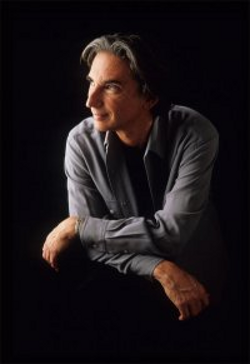 Michael Tilson Thomas [Photo by Chris Wahlberg]
Michael Tilson Thomas [Photo by Chris Wahlberg]
Brewer makes this look easy. No one can qualify the Illinois native’s German as anything but romantic. She gets right to vowels, hanging on ever so lightly, giving consonants that snap that settles on the ear. Brewer exercises a judicious mix of vibrato treatments over a warm stream of sound and a tonal quality similar to Jessye Norman’s, with a more forward placement. The lower register is remarkably secure and round, climbing as that one proverbial “column of sound,” a sound that was born to soar. She reaches high-note territory (E, F and G) with ease; yet she builds phrases with sincerity and depth, which takes a tremendous amount of discipline. This is what she does; and it makes Brewer all the more special.
Billed as an evening of “Tricks and Treats,” New World Symphony (NWS) and Artistic Director Michael Tilson Thomas hosted Brewer at the Knight Concert Hall on October 29th. The vocal portion of the concert consisted of Richard Wagner’s Wesendonck Lieder, what amounts to a serenade the composer created to the poems of his muse at the time, Mathilde Wesendonck, who is described as “one of the most significant women in Wagner’s life” in the program notes.
Even when Christine Brewer could let loose through Wagner’s five lied, she drew out plaintive tones that were an integral part of the story, saving her considerable powers for the articulation of German. Such was the case for “Der Engel,” where vocal control goes a long way in conveying how the selflessness of angels fills the hollowness of human existence. Brewer sang phrases that left one breathless, literally and figuratively.
Internal suffering was in full effect in “Im Treibhaus — Studie zu Tristan und Isolde,” where Brewer, Tilson Thomas and orchestra teamed for a moment of otherworldly waves of music, with violins playing off of one another in a way rarely heard. Brewer held a certain musical line while drafting steamy tones over the phrase “Malet Zeichen in die Luft,” where Wagner speaks to the horticulture of supernatural dispositions, asking nature to disclose its wonders.
“Schmerzen” brings more opportunity for vocal muscle, right from the first notes of the vocal line. Here still, Brewer created tones that came across as gentle acceptance of nature’s abiding relationship between life and death.
A conducting “Golden Age” for these times surely comes in the presence of Michael Tilson Thomas. He deserves the appellation Musikmeister. In NWS — America’s only full-time orchestral academy — he has a splendidly boundless and stimulating canvas with which to put to use and to share his inestimable experience and multitudinous skills. Michael Tilson Thomas and Christine Brewer are, individually, artists that bring a certain magic to everything they do. Together, Tilson Thomas and Brewer cause all aspects of a musical show to come into phase.
Tilson Thomas’ dancing with the New World Symphony is unison personified. In “Schmerzen,” where the descending scale of forte strings and winds calls for sudden passion and intra-instrument matching, the sound entered as if warmed up from a few bars back. The NWS conductor carries instrumentalists along with him — wrist rolls move bows and sway woodwinds; he revved up the baton to urge tempi, and brought horn players to the balls of their feet. It all happened at once. Tilson Thomas steps in the direction of a section, calling on them to build sound space, gesturing directions with his left hand, and pointing to have players attend to specific features. Thomas’ communication with Brewer was intense. He sought out her inflections and movements signaling different moods and changes in musical design.
The concert opened with Richard Strauss’ Till Eulenspiegel’s Merry Pranks and ended, after the Wagner lied, with Johannes Brahms’ Symphony No. 1 in C minor. Strauss’ tone poem is an excellent vehicle to show off NWS. Its light beginning and exposed horn and long staccato violin stretches — all the way through the build up and Strauss’ playful winds and wide use of the percussion family — were played with nice contrasts, zinging accuracy and stamina to spare.
NWS showed versatility, power and pathos beyond their years in Merry Pranks and especially in the Brahms. The second movement was guided by Tilson Thomas as a soft hymn with hanging phrases of elegance and downward spins taken with care for keeping a joined soundscape. Improbable as it is, instrumentalists managed the most organic playing in the most demanding of Brahms’ orchestral drawings, the final movement. NWS took its shifts from driving chords to lush orchestral effects, creating a tightly held story right through to the ceremonial finish.
“Golden Age” or no, any night like this — pairing starry singer and starry conductor with a very hungry group of instrumentalists — ranks up there with any of the most vaunted classical musical moments, anywhere, anytime.
Robert Carreras
For more information about New World Symphony check www.nws.edu
image=http://www.operatoday.com/BrewerPhotoChristianSteiner.png image_description=Christine Brewer [Photo by Christian Steiner] product=yes product_title=Richard Strauss: Till Eulenspiegel’s Merry Pranks, Op. 28; Richard Wagner: Wesendonck Lieder (orch. Felix Mottl); Johannes Brahms: Symphony No. 1 in C minor, Op. 68. product_by=Christine Brewer, soprano. New World Symphony. Michael Tilson Thomas, conductor. Adrienne Arsht Center, Knight Concert Hall, Saturday, 29 October 2011. product_id=Above: Christine Brewer [Photo by Christian Steiner]November 15, 2011
Eugene Onegin, ENO
Fittingly for a work drawn from Pushkin’s verse novel, Warner’s vision is literary in its inspiration. Moving the action forward fifty years, from Pushkin’s 1840s to the late-nineteenth century, the director and her designer, Tom Pye, conjure a moving picture of Chekovian ‘twilight moods’. The pace is gently controlled; beautifully rendered natural scene drops unfold, like pages of a book, as we move through the chapters of the protagonists’ lives. The visual detail and accuracy of observation recalls Chekhov’s stylised blend of realism and romance.
Pye’s designs are sumptuous and surprising. The imposing ballroom columns of the third act, through which polonaising couples burst, justly won an instantaneous gasp of applause; cleverly, as the suppressed emotions of the social interior are exchanged for the freedom of the natural exterior, the splendid pillars become terrace colonnades – their majesty emphasising the tragic frailty of the protagonists. Most impressive was the silvery lakeside expanse of the second act, all glistening ice, wintry branches and shimmering mist – perfectly capturing the frozen emotions of the duellists who are alienated by jealousy, pride and convention.
The only puzzle was the vast barn of act one, which replaced the usual winter dacha. It was not clear why members of the fairly wealthy Larin family slept in what looked like an outbuilding. And, such an immense expense, stretching into the wings and up to the flies, was not the ideal location for Tatiana’s letter scene, which requires a sense of intimacy and constraint. Jean Kalman’s striking lighting did help: violent shadows loomed ominously behind the tormented heroine, and the gleaming sunrise which heralded the end of the act was almost painful in its gradually deepening intensity. The designs were complemented by Chloe Obolensky’s detailed naturalistic costumes.
Of the strong cast assembled, it was Toby Spence, as a fervently passionately Lensky who shone brightest. A sustained and utterly convincing dramatic interpretation was matched by a faultless vocal performance. In particular, in his act 2 aria preceding the duel, Spence delivered an exquisite pianissimo passage of reflection, poignantly recognising and regretting that even genuine fraternal love could not prevent pointless annihilation of life. The tensions and antagonisms between Lensky and Onegin were visually suggested by the taut diagonal line that the men formed as they ranged their rifles, Lensky sited to the rear of the stage, already receding from life. Warner’s attention to detail was impressive in this scene; telling touches, such as Onegin’s removal of his hat, subtly shaped the audience’s response.
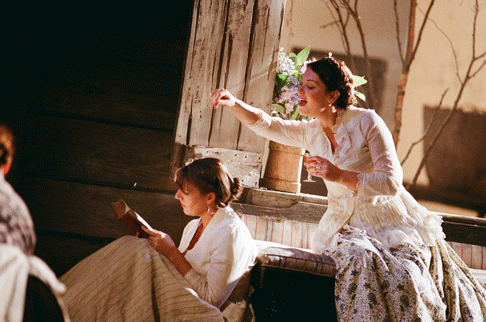 Amanda Echalaz as Tatiana and Claudia Huckle as Olga
Amanda Echalaz as Tatiana and Claudia Huckle as Olga
Lensky’s romantic ardour was such that it is hard to imagine how he could have formed such a strong friendship with the coolly aloof Onegin of Audun Iversen! It is a role that the Norwegian baritone has tackled to acclaim several times before; in this production, his Onegin is not a dastardly villain but wavers between blunt honesty and immature self-indulgence. He is bored by and frustrated with stifling social conventions. Although a little constrained to begin, by the final act Iversen’s beautiful mellow tone, with its rich low notes and free, relaxed in upper register, went some way to winning the audience’s sympathy for this flawed dreamer.
Having recently taken audiences by storm as Tosca at both of London’s main houses, Amanda Echalaz’s Tatiana was a little disappointing. There is no doubting the wonderful strength and depth of her voice, and her secure chest notes are impressive. Tatiana’s elegiac passion was powerfully conveyed. But, Echalaz’s tone was rather one-dimensional. She has admirable stamina and there was lots of power, but not much light and shade. There were some moments of gleam, but on the whole both more radiance and more fragility were required in order to convey Tatiana’s tragic vulnerability and emotional frailty. There were some intonation problems too, particularly a tendency for the fortissimos to stray sharpwards.
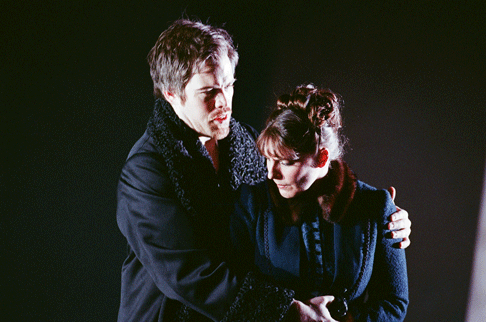 Auden Iversen as Onegin and Amanda Echalaz as Tatiana
Auden Iversen as Onegin and Amanda Echalaz as Tatiana
The principals were well supported by the minor roles. Diana Montague (Larina) and Catherine Wyn-Rogers (Filippyevna) were superb, while Claudia Huckle was a lively, impassioned Olga. Brindley Sherratt, who impressed in ENO’s recent Simon Boccanegra, displayed gravitas and honesty as the elderly Gremin. In the cameo role of Monsieur Triquet, Adrian Thompson almost stole the show!
The thunder of the enlarged chorus in the climactic moments was rich and thrilling, although they were a little untidy at times. The stage was crowded, with children and dancers adding to the maelstrom. Kim Brandstrup’s choreography combined stylised realisation of Russian peasant culture enriched with modernist gesture; both in the opening act and the later ballroom the dances served to establish cultural mannerisms and social hierarchies.
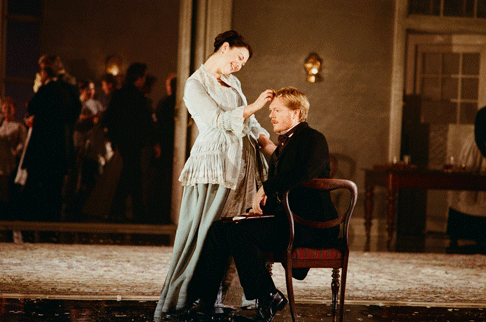 Claudia Huckle as Olga and Toby Spence as Lensky
Claudia Huckle as Olga and Toby Spence as Lensky
Edward Gardner conducted with consummate appreciation of the spirit and pace of the opera: he and Warner allow space for emotive silences, most tellingly in letter scene. Pauses between scenes and acts suggest that while life hangs suspended, later everything will inevitably change. Sudden surges of rapturous orchestral outpouring are contained within controlled musical forms, as the repressed souls fleetingly give vent to romantic yearnings. Gardner’s attention to detail is masterly. Nothing is over-stated. Tchaikovsky’s score is not so interested in external worlds but in the characters’ inner development, just as in Chekhov’s plays the poetic power is hidden beneath surfaces, and so reveals the true depths of human experience.
Martin Pickard’s translation is rather mundane at times although he captures some of the original’s lyricism in the set pieces. Pushkin’s tale may be a fairly clichéd account of unrequited love, missed opportunities and the conflict between passion and convention, but it is a tale with which all can surely identify. If despair and hopelessness dominate, there is still radiance amid the torture. From quiet beginnings, Warner allows huge human passions to emerge. She simply lets the music tell its story.
Claire Seymour
image=http://www.operatoday.com/Onegin_ENO_2011_02.gif image_description=Amanda Echalaz as Tatiana [Photo by Neil Libbert courtesy of English National Opera] product=yes product_title=Pyotr Ilyich Tchaikovsky: Eugene Onegin product_by=Eugene Onegin: Audun Iversen; Vladimir Lensky: Toby Spence; Tatiana: Amanda Echalaz; Olga: Claudia Huckle; Filippyevna: Catherine Wyn-Rogers; Monsieur Triquet: Adrian Thompson; Madame Larina: Diana Montague; Zaretsky: David Stout; Prince Gremin: Brindley Sherratt; A Captain: Paul Napier-Burrows; Peasant Singer: David Newman. Director: Deborah Warner. Conductor: Edward Gardner. Orchestra of English National Opera. Set designer: Tom Pye. Lighting designer: Jean Kalman. Costume: Chloe Obolensky. Choreographer: Kim Brandstrup. English National Opera, Coliseum, London, Saturday 12th November 2011. product_id=Above: Amanda Echalaz as TatianaPhotos by Neil Libbert courtesy of English National Opera
November 14, 2011
Dark Sisters, New York
An operatic treatment was sure to appear in due course, but due course in opera-land usually takes at least a generation. Not this time! Young Nico Muhly’s Dark Sisters, about five wives of a polygamous “prophet” who has been accused of abusing his twenty-odd children, had its premiere this month in a visually and aurally sumptuous production by Gotham Chamber Opera and Music-Theatre Group that will travel in June to its co-producer, the Opera Company of Philadelphia.
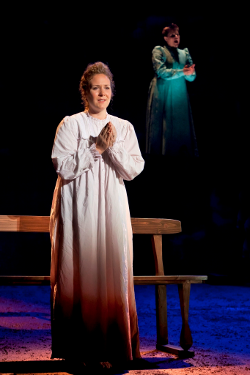 Caitlyn Lynch as Eliza and Kristina Bachrach as Lucinda
Caitlyn Lynch as Eliza and Kristina Bachrach as Lucinda
Having no previous acquaintance with Muhly’s music, I was tremendously impressed by his skill at writing for both chamber orchestra (13 musicians) and voice. First of all, he can write for the voice, in a sensuous, gratifying way that suits the voices doing the singing. It might be called an instrumental manner: Voices, solo or in combinations in various ranges echo or mimic the way he pairs unusual combinations of instruments to shade or emphasize a line of text or an unexpressed emotion, a violin with an English horn or a flute with celesta. There are striking effects that support a scene or a moment more subtly than the high melodramatic manner opera is used to. To a scenario with very little stage action, Muhly brings vivid musical activity, interesting even when its working out is not what the listener might have expected.
For one striking example, Act I closes with the Prophet choosing to spend the night not with one of the four biddable wives who yearn for nothing else, but with Eliza (Caitlin Lynch), the wife for whom the assault of the outside world and the taking of her daughter, Lucinda, has crystallized years of disaffection. Though she is submissive in word and gesture, Eliza’s disgust at the Prophet’s marital rape—her memories of her wedding night at sixteen, her escape into fantasies (which, it is implied, have been getting her by for years)—are indicated by a subtle agitation, ripples of percussion and harp, that express her state of mind with perfect economy, and the repulsive occasion is staged with spare good taste. Compare the perfervid scenes of sexual violation in Floyd’s Susannah, Loesser’s Most Happy Fella, Ginastera’s Beatrix Cenci, Britten’s Lucretia. Britten is one of Muhly’s obvious models; so is Samuel Barber—I departed humming Vanessa’s “In stillness, in silence, I have waited for you.” But Muhly’s music could not be mistaken for either Britten or Barber; it is too lush for the former, less melodically giving than the latter.
Impressed as I was by the aural textures and the skillful mood painting of Dark Sisters, I felt distanced, confused, by Muhly’s tonal but astringent melodic language, so ambitiously displayed. There seemed, at least at first hearing, too eager a sidestep from the easily caught phrase. When not harmonizing, too many of the vocal lines sounded like recitative sung with feeling. The varieties of sound and the sheer gorgeousness of the women’s voices led us eagerly from place to place, but this aversion to anything simple or basic made the traditional hymn tune “Abide with Me,” when it turned up in the final scene, unduly attractive, a relief for the ear kept on edge. Perhaps that was the intention, the composer’s riff on our preference for neater drama and more melodiously appealing characters—his modern twist on the adage that the Devil gets the best tunes. For by this time the plot of this very internal opera had taken some curious turns, one (Eliza’s flight), foreshadowed and satisfying, others not so easy to parse. The ending is ambiguous rather than self-righteous or pat; we are satisfied and unsettled at the same time.
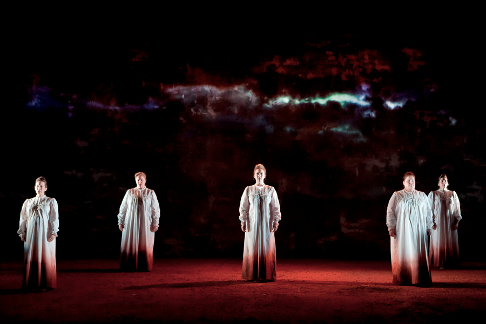 Left to right: Jennifer Zetlan as Zina, Margaret Lattimore as Presendia, Caitlin Lynch as Eliza, Jennifer Check as Almera and Eve Gigliotti as Ruth
Left to right: Jennifer Zetlan as Zina, Margaret Lattimore as Presendia, Caitlin Lynch as Eliza, Jennifer Check as Almera and Eve Gigliotti as Ruth
As the opera begins, the women mourn for their children, seized by state authorities, and from their interwoven mourning individual natures gradually announce themselves. Their husband, the Prophet, flees to the desert—seeking communion with God’s messengers, he says—and their discontent is left to seethe and bicker and recall the past without him. Ruth has lost her children because the Prophet would not permit doctors to come from outside. Zina is proud of her new sewing machine, the Prophet’s gift; Presendia resents that gift and takes her own refuge in art. They pine for their husband and resent him; they accept the restrictions of their life, the only life they know, but rebellion simmers. And Eliza, who does not enjoy her husband’s attentions as the others do, is horrified when she discovers he has promised her fifteen-year-old daughter to an elderly friend. In Act II, on an amusing, not too forced parody of a TV news show, a self-important newscaster who clearly regards the wives as freaks, puts them on screen to discuss their polygamous plight. The women refuse to condemn their own distinctive lives. Presendia points out: “It’s not a compound; it’s a ranch … our home! … This is America! … In some states they let men marry other men!” But Eliza, as we knew she would, seizes the opportunity to escape.
Stephen Karam’s libretto is spare on action. Instead, he presents the internal drama of the female protagonists, glancing on all the expected themes with a blessedly light touch that Muhly has matched: There is just enough conflict between the wives, not too much; there is just enough sermonizing, not too much. Nor does Karam oversimplify the issue of what such women are to do with themselves if they do break free: Where would they go? How are they to live? It’s no simple matter, and Karam does not brush it off or assume that we will take a certain side (though of course, most of us sophisticated, secular opera-goers will).
This is one of the epic stories of our time, and not just for child brides on a Southwestern ranch. At adolescence, in many societies, girls are given to older husbands to forge alliances while boys are often “excommunicated,” banished friendless and unprepared to the world they have been raised to distrust. Similar tales come from other traditional societies in revolutionary times: the Hasidic Jews, the Reservation Indians, or the youth of cultures where women are veiled or circumcised and daughters ill-educated, not daring not protest traditional decisions. Raised to believe the outside world is hostile and sexually exploitive (and isn’t it?), they must choose between a known space with dependable family love and finding the courage to give it all up for the terrifying unknown. For most individuals so trapped, this is neither a simple nor an obvious choice. To Karam and Muhly’s great credit, in boiling such matters down to a 100-minute operatic presentation, they never suggest that the solutions are simple, obvious or predetermined; they do not slight the attractions to remain or those of departure. Dark Sisters is not a snide fable; it is a sincere effort to get under the human skin of the problem.
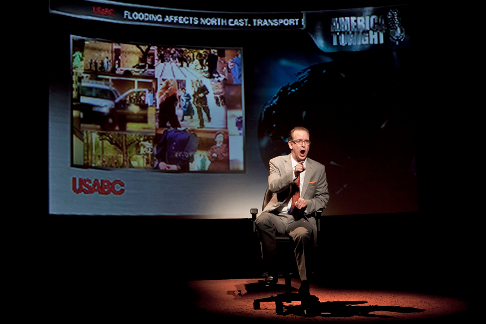 Kevin Burdette as Prophet/News Anchor
Kevin Burdette as Prophet/News Anchor
The production design (director Rebecca Taichman, sets and video by 59 Productions, lighting by Donald Holder) might be a textbook for the latest in multi-media opera (projections, double screens, films within films, lighting in back, in front, all around), but who ever designed a textbook this beautiful? The gray lives of the women on their ranch are expressed by their white, nightgown-ish dresses set between red-brown desert sands and blazing skies, and their visions of star-filled nights and cloudy, alluring paradises glow.
It would be difficult to single out one of the five singers playing the Prophet’s wives: Each presented a rounded, individual woman (in defiance of their near-identical costumes), and their voices were all of them warm, tactile, filling the theater in glorious interweavings with no hint of strain. When their voices reached out, as each one did in her turn, we seemed to hear their separate souls, dutiful or desperate, jealous or exalted or depressed. We came to know them, from resentful, dreamy Eliza (Caitlin Lynch), miserable, ecstatic Ruth (Eve Gigliotti), queenly Presendia (Margaret Lattimore), pert Zina (Jennifer Zetlan), determined Almera (Jennifer Check) and Lucinda (Kristina Bachrach)—whose real self (seen in Act II) may not be quite the same as the child of her mother’s fantasies in Act I. Kevin Burdette, in the two thankless roles of the Prophet and the equally unsympathetic newscaster, alone did not get a lyrical flight. He bore his deprivation with stoicism. Neal Goren conducted the orchestra and the complex interactions of instruments with voices masterfully.
One must mention that the small, handsome Lynch Theater in John Jay Law School on Tenth Avenue was filled with an enthusiastic and, by operatic standards, extremely youthful audience. They can’t all have been classmates of the composer (who is thirty), but they were clearly delighted with the opportunity to hear the music of a contemporary.
John Yohalem
image=http://www.operatoday.com/RT_MG_0141A%20copy%20small.png image_description=Eve Gigliotti as Ruth [Photo by Richard Termine] product=yes product_title=Nico Muhly: Dark Sisters product_by=Eliza: Caitlin Lynch; Ruth: Eve Gigliotti; Almera: Jennifer Check; Presendia: Margaret Lattimore; Zina: Jennifer Zetlan; Lucinda: Kristina Bachrach; Prophet/News Anchor: Kevin Burdette. Gotham Chamber Opera (in association with Music-Theatre Group and the Philadelphia Lyric Opera), conducted by Neal Goren. At the Gerald W. Lynch Theater. Performance of November 11. product_id=Above: Eve Gigliotti as RuthPhotos by Richard Termine
Carmen in San Francisco
Of the several step-ins one seemed the most unlikely. But American lyric mezzo Kate Aldrich surprised everyone with a Carmen that was splendidly charismatic. Five years later la Aldrich, now a Rossini diva as well, was to be the centerpiece for eleven performances of this get-em-in-the-opera-house war horse. Guess what!
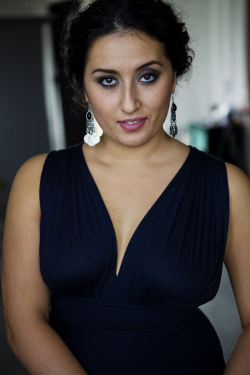 Anita Rachvelishvili [Photo courtesy of San Francisco Opera]
Anita Rachvelishvili [Photo courtesy of San Francisco Opera]
But this time, so far, the replacements have been very likely Carmens. American mezzo and recent Adler Fellow Kendall Gladden took the first two performances. This fine young artist has already distinguished herself as a viable Carmen on several of the world’s major stages. Georgian diva Anita Rachvelishvili, a veteran of the role at La Scala, the Met, Munich, etc., has now made her local debut and takes the next four performances as well. San Francisco Opera still hopes Mme. Aldrich may arrive for the final four performances, but stay tuned.
The problem is that Kate Aldrich is a very specific artist. She has a tonality that incorporates her quite lyric voice with a bright, American presence. It would seem that San Francisco Opera built its cast around this formidable persona and that meant lighter voices and lighter weight personalities. And since Carmen is a dialogue and numbers opera anyway the artistic concept seems to have been to make it a true operetta-like musical.
A light-weight cast was the result. Young Brazilian tenor Thiago Arancam was an adolescent looking and sounding Jose whose singing gave great pleasure but who lacked the power to make Jose’s frustration and rage seem more than a temper tantrum. Current Adler Fellow Sara Gartland possesses a small, quite lovely voice with an engaging flutter. She was a Micaela blown about the stage by the whims of a few soldiers and smugglers rather than the stolid emotional force of Jose’s ties to his mother.
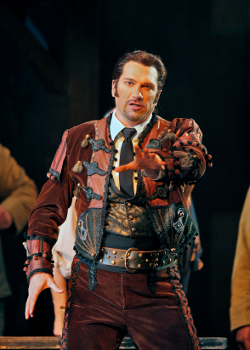 Paulo Szot as Escamillo
Paulo Szot as Escamillo
Brazilian baritone Paulo Szot was the Escamillo. His claim to fame is the role of Emile De Becque in a Broadway revival of South Pacific and as the caricatural Shostakovich Nose at the Met. Mr. Szot simply lacks the operatic coglioni to fight bulls and seduce Carmen, but he did make a more or less pretty figure on the stage.
All this light artillary confronted a Carmen of maximum operatic magnitude, Anita Rachvelishvili. Mlle. Rachvelishvili has a big, big voice that she manages with grace and subtlety, and she does project a forceful personality if not a particularly sexual one. She apparently arrived in enough time to get her mind around the production’s dialogues but hardly in time to be integrated into its staging, if there ever was any. As it was she made generic Carmen moves from time to time.
This 1981 Jean Pierre Ponnelle production once had an edge. It was in fact the first time Bizet’s spoken dialogues were incorporated at the War Memorial and among the first times on any major stage in the world. To effect such daring Ponnelle obviously needed to downsize the public’s idea of Carmen from grand opera to a music hall ambiance.
This need accounts for the small false proscenium embedded in a massive, full stage stone wall. The little proscenium opens and closes upon some historical scenic ideas (as well as a few more sophisticated techniques) that Ponnelle uses to substitute for the grand opera ideas of locale and ambiance.
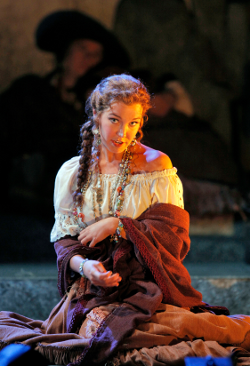
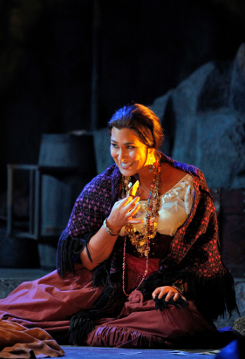 Susannah Biller as Frasquita (above) and Cybele Gouverneur as Mercedes (below)
Susannah Biller as Frasquita (above) and Cybele Gouverneur as Mercedes (below)
But more than anything else the stone wall foreshortened stage depth determining that the staging be presentational, like music theater once was (and maybe still is). Can this explain why Jose seemed to be singing the "Flower Song" to the audience? And why Jose and Escamillo confronted one another without confronting one another (they seemed to be confronting the conductor). While the program does credit a fight choreographer these several crucial events that we look forward to in Carmen were inordinately weak.
Meanwhile, o Dio, we had Nicola Luisotti in the pit, a more formidable opera conductor cannot be imagined. Once again blatant staging concessions were obviously made to this tyrannical maestro so that all his musical points could be maximally vivid. And vivid Bizet’s music was. Maybe it was the point and flash of the music that made the stage seem so painfully pallid and therefore undermined our enjoyment of the performance.
Of the comprimarios the Dancairo of Timothy Mix had real flash, and the Moralès of Trevor Scheunemann well filled the stage. Adler Fellow Susannah Biller as Frasquita lacked the brilliance and volume of the high notes needed to vocally anchor the big ensembles. Wayne Tigges as Zuniga failed to find the fascistic stance that the Ponnelle production introduced to establish a political tyranny equal to the emotional tyranny imposed by Jose's mother.
The fashion to use the very compromised (i.e. hugely shortened) opéra comique dialogues in big opera houses has long since disappeared, and it is time to retire the Ponnelle production rather than destroy its integrity by producing it in unfavorable circumstances. The French dialogues just now were a pleasure however, easily understandable to anyone with high school French. Cleverly one Frenchman was introduced into the cast, Micaela’s mountain guide boy, so that we could hear what real French sounds like.
Michael Milenski
Click here for additional information regarding this production.
image=http://www.operatoday.com/F--Act-I.png
image_description=Thiago Arancam as Don Jose and Sara Gartland as Micaela
product=yes
product_title=Georges Bizet: Carmen
product_by=Carmen: Anita Rachvelishvili; Don José: Thiago Arancam; Micaëla: Sara Gartland; Escamillo: Paulo Szot; Frasquita: Susannah Biller; Mercédès: Cybele Gouverneur; Le Dancaïre: Timothy Mix; Le Remendado: Daniel Montenegro; Moralès: Trevor Scheunemann; Zuniga: Wayne Tigges; Lillas Pastia: Yusef Lambert. War Memorial Opera House. San Francisco Opera Chorus and Orchestra. Conductor: Nicola Luisotti; Stage Director: Jose Maria Condemi; Set Designer: Jean Pierre Ponnelle; Costume Designer: Werner Juerke; Lighting Designer: Christopher Maravich. Performance of 12 November 2011.
product_id=Above: Thiago Arancam as Don Jose and Sara Gartland as Micaela
All production photos by Cory Weaver courtesy of San Francisco Opera
November 13, 2011
Jonas Kaufmann as Werther and Cavaradossi
The sad corollary has been a feeling that the more heroic tenor sound — often called “spinto” — has gone lacking for fresh talent. Rolando Villazon tried to move from the light roles into the heavier, and a vocal crisis ensued. And just recently we lost to a tragic accident Salvatore Licitra, who a few years ago had seemed poised to attain true stardom in spinto roles.
Now comes Jonas Kaufmann, German by birth, and in his early 40s. He established himself on European stages and has gone on to make some notable appearances in the U.S. His is a strong, masculine sound, as handsome as the man himself. The vocal colors include deeper hues, as with Placido Domingo, but his top seems to be more reliable than Domingo’s often was. So far the greatest acclaim has come to Kaufman in Wagner, but he is by no means limiting himself to Lohengrin and Siegmund. His Don José for Covent Garden made it to DVD, and now Decca has released a Werther from Paris in 2010 and a 2009 Zürich Tosca with Kaufmann’s Cavaradossi. Both DVDs put on display a confident, poised tenor whose stardom obviously stems from a lot more than his good looks. For some he may never be a true spinto in Italian repertory, due to his nationality, but then those same fans (or their “ancestors”) felt the same about Jussi Bjorling. His is a different type of voice, larger and darker, but Kaufmann probably has no qualms in following the great Swedish tenor’s path.
Film director Benoît Jacquot’s Werther staging for Paris (although initially presented at Covent Garden) leaves wide open spaces for Kaufmann to fill with his stage presence, which the tenor has no problem doing. The set for the first half vaguely resembles a strand near a seashore on an overcast day, while the second half is staged in a vast study, dark and masculine in appearance. Director Jacquot uses these simple surroundings as platforms for emotional interaction, rather than symbolic display. Unfortunately, Jacquot, working with Louise Narboni, indulges in some odd camera angles as a video director, and he also makes use of backstage footage in a gambit that proves initially interesting but ultimately annoying.
Massenet’s opera respects the Goethe source material almost too much, as two hours with a dreary emotional wreck amounts to around 119 minutes more than most people would want to spend, even with such gorgeous music. Kaufmann’s Werther shines in his opening paean to nature, the character’s only few minutes in the opera not spent being a moody, lovesick drip. Even more impressive, though, is Kaufmann’s ability to draw the audience into Werther’s plight, so that the intolerable self-pity is muted by a sense of larger social forces oppressing the anti-hero. A big part of Kaufmann’s success lies with the sheer power and authority of his voice. There is no resorting to sobs or ostentatious drooping of the vocal line. Kaufmann lets the inherent pathos of Massenet’s score fill out the emotional picture.
As the object of Werther’s passion, Sophie Koch plays too much to Charlotte’s modest beauty, both in demeanor and voice — there must be some passion there to make us understand the depth of Werther’s attraction. Ludovic Tezier, on the other hand, is almost aggressively bland and prosaic as Albert, the man Charlotte must marry to fulfill a promise she had made. The veteran conductor Michel Plasson and the Paris musicians unfurl gorgeous swaths of color and texture in Massenet’s score. Decca’s two disc set has no bonus feature, though the booklet does have more original material than the usual DVD set booklet offers these days.
Robert Carsen’s Tosca for Zürich would make the NY audiences that bayed at Luc Bondy’s production for the Metropolitan howl and foam as if rabid. Carsen sees Puccini’s take on the Sardou play as anticipating the glory years of the American film studios, so the sets and costumes (by Anthony Ward) play upon the libretto’s settings to create a sort of mock film set, and at times a stage proscenium. Most of it works quite well, as Tosca and Scarpia are both inherently theatrical creatures, and Kaufmann’s Cavaradossi is more in line with the strong, though not so silent, type of leading man. A couple of bolder touches will not work well for all viewers — whether it’s having Cavardossi’s Madonna painting appear in Scarpia’s office during act two or having Scarpia attack it with a knife. Your reviewer got a big kick out of Tosca’s fatal leap taking place over the footlights at the edge of a stage, topped with Emily Magee taking her solo call in character. Others may not be amused. But the test of any Tosca is if it can find the emotional truth of the drama while breaking through the calcified stage directions that make the drama too clichéd to make any impact, and Carsen does so, with the invaluable assistance of his excellent leads.
Vocally, Kaufmann takes the prize. His solo pieces are gorgeous, and he can roar out a “Vittoria” with the best of them. Magee’s Tosca is best in the dramatic exchanges. Her large voice grows gritty and unpleasant in extended lines, and though Carsen has Thomas Hampson’s Scarpia applaud Magee’s “Vissi d’arte,” his sarcastic look is unfortunately understandable. Hampson’s take on Scarpia has freshness and edge, but it seems unlikely he will take on this role at any of the larger American houses. By the middle of act two, hoarseness scratches at the edge of his voice. Taken together, though, all three leads are successful enough to make this a very worthy competitor in the very crowded field of Tosca on DVD.
An unfamiliar name, conductor Paolo Carignani treats the score to a fresh approach, with expansive pacing and an expert selection of orchestral detail. The Zürich forces follow his lead beautifully. Decca’s single disc set has a basic essay and synopsis in the booklet and no on-disc bonus features.
Kaufmann will be in huge demand for years to come, and US audiences will have to wait their turn for his future appearances here. With two fine DVDs such as these, at least we have something of the tenor’s to watch while we wait.
Chris Mullins
image=http://www.operatoday.com/Decca_0743406.png
image_description=Decca 0440 074 3406 2 [DVD]
product=yes
product_title=Jules Massenet: Werther
product_by=Werther: Jonas Kaufmann; Charlotte: Sophie Koch; Albert: Ludovic Tézier; Sophie: Anne-Catherine Gillet. Orchestre de l’Opera national de Paris. Conductor: Michel Plasson. Director: Benoît Jacquot.
product_id=Decca 0440 074 3406 2 [DVD]
price=$37.99
product_url=http://www.arkivmusic.com/classical/album.jsp?album_id=517343&album_group=2
Adriana Lecouvreur, Carnegie Hall
The Opera Orchestra of New York seemed to edge the shadows quite lately, but its return to Carnegie Hall with Cilèa’s fragrant Adriana Lecouvreur was ardently welcomed by something like a sell-out crowd—and why not? The cast, headed by Angela Gheorghiu and Jonas Kaufmann, could hardly have been more up-to-the-moment starry. Adriana is not the obscure sort of fare for which New York’s opera lovers have long treasured the company, being an occasional visitor to the Met as well as to OONY in recent seasons, but no one seemed to mind that. Even better news was the remodeled and repeopled orchestra itself under its handsome new conductor, Alberto Veronesi, producing Cilèa’s masterful and dreamy effects all night up to the ethereal harps that accompany the expiring Adriana to the throne of Melpomene, Muse of Tragedy, on Mount Parnassus. They made one almost eager to hear OONY’s next offering, Wagner’s Rienzi, on January 29th. A maestro of Veronesi’s ability might find elegances in that bombastic work that have previously escaped our attention.
Adriana has its bombastic moments too, but it largely sticks to formal “Verist” manners: continuous song inspired by dialogue and personality; the opera lacks even the audience sop of an act finale of singers in full concerted blast. Adriana is based—it is the last successful opera based—on a script by the indefatigable (but, by 1902, long dead) Eugène Scribe, and like all Scribe historical farragoes, “illustrates” historical problems by placing the feelings of characters, real or fictitious, in the foreground with a claque of intricate skullduggery to surround it and elicit our thrills and chills of sympathy—the technique of “historicality” bequeathed by Scribe to Hollywood. In Adriana, the great actress, in love with a mere officer, learns that he is actually Maurice de Saxe, son of the king of Poland, eventually a marshal of France, and aspirant to the throne of Courland. (Where? Latvia. Same as Latvia. Roughly. But don’t worry; the whole show takes place in Paris.) Maurizio (as he is here) has concealed his identity because, for political reasons (Courland again), he has been courting the passionate wife of the mighty Prince de Bouillon. The Prince never suspects Maurizio is his wife’s lover, but he does suspect the gallant officer of seducing his mistress. That would call for a duel. Add a lot of complications in a darkened room by two desperate women who must not see each other’s faces, and a nastily-wielded speech from Racine, and a bunch of poisoned violets. In life, Maurice and Adrienne had a child, whose great-granddaughter was George Sand, a pal of Scribe’s. And Maurice never did get Courland. Never mind.
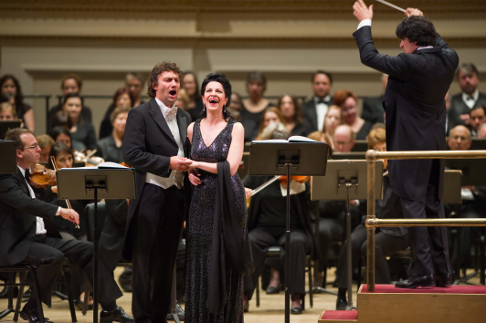 Jonas Kaufmann and Angela Gheorghiu [Photo by Stephanie Berger courtesy of Opera Orchestra of New York]
Jonas Kaufmann and Angela Gheorghiu [Photo by Stephanie Berger courtesy of Opera Orchestra of New York]
Angela Gheorghiu has a lovely voice but her choice of repertory and the way she uses the instrument have seldom delighted me. On this occasion, while her diva mannerisms no doubt recalled the old days to those who missed them (in either sense), she was for me the least satisfying singer. This may be a case of being too busy studying the notes to bother with the story. Adrienne Lecouvreur was the queen of the Comédie Française because she brought naturalism, or what passed for naturalism in 1730, to a stage frozen in the affectations of “high art.” This is the message of Adriana’s entrance aria, “Io son l’umile ancella,” when, in response to her colleagues’ applause, she assures them she merely inhabits the text as it has been written. Obviously, a great actress does much more than that and a great singer should present the aria as naturalism on her own particular terms—but it must be natural on some terms. Gheorghiu can be many things on stage—pathetic, passionate, sexy, tragic, outraged, outrageous—but she is never natural. That’s all right as long as you sing “Io son l’umile ancella” in a natural fashion, its strophes considered, its raptures and confidences part of a whole (the way Mirella Freni sang it—got that?), but Gheorghiu isolated the phrases into separate Post-It notes on her performing style, never joining them into a whole and demolishing Cilèa’s loveliest melody. Maestro Veronesi followed her devotedly: A star is a star. A friend suggested that he wasn’t conducting the orchestra at all—Gheorghiu was doing it herself with all those tossings and flutterings of her elegant gown.
After a costume change in the interval—divas rule!—Gheorghiu seemed more prepared to sink into the score (which she recently performed in a full staging at Covent Garden). The spoken tirade from Racine’s Phaedra in Act III was, to these ears, her finest vocal moment although one might cavil that it isn’t exactly sung. Her “Poveri fiori,” if once again wayward in tempo, took us closer to the character than anything else all night.
Jonas Kaufmann is not the ideal Latin tenor lover (one reason his Alfredo at the Met was predictably disappointing), but he has such advantages, such a robust, attractive baritonal color to his voice with a seemingly effortless reach to the top, such musicality, such charisma, such devotion to creating his part (which meant here that he had to convince two jealous women of his unflawed fidelity—no trouble for Kaufmann—we all wanted to believe he was in love with us, and it’s easy to believe what you want to believe when it’s sung like that), that I was as starry-eyed as the rest of the house. When I say he lacks “Latinity,” I mean that when he does go for emotional high points, declaring his love or recounting a bold military exploit, though the phrases ring, he does not sound ready to die to take that redoubt, I mean high note. That is the effect of the ideal Verismo tenor. Kaufmann is German: brainless testosterone is just an act for him.
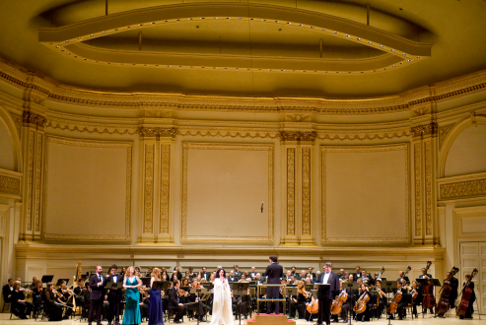 Full cast [Photo by Stephanie Berger courtesy of Opera Orchestra New York]
Full cast [Photo by Stephanie Berger courtesy of Opera Orchestra New York]
Anita Rachvelishvili has been singing Carmen to acclaim all over the world, and she did not seem to have renounced the street Gypsy when singing the jealous Principessa here. She seems a very young singer, but the Principessa (unlike so many of her interpreters) is not old; she is a disappointed young woman trapped in a marriage to a noble roué; Maurizio has waked a smoldering volcano. Rachvelishvili has a deep, smoky sound with a vibrato that can be thrillingly suggestive or vaguely spooky and wide of pitch. Her Principessa was full of sass. I wonder what her Dalila might be like?
Ambrogio Maestri, resembling a thick-lipped, sentimental concierge in a romantic farce, brought a far more impressive sound to Michonnet, Adriana’s hopeful manager, than the lovesick fellow usually gets. The smaller roles were cast appealingly, especially Nicola Pamio’s mincing abbé and the four twirling actors who cheer Adriana on her birthday. The orchestra sounded reborn, revivified, ready for anything. I hope that means they will take on many scores they have not played for us before—there’s a lot of terrific bel canto that’s just coming to light. Or if they stick to encoring previous O.O.N.Y. successes, may one suggest Robert le Diable? Nerone? Poliuto? Beatrice di Tenda? I missed them last time through, and they’re certainly worth more than one glance. Or Bizet’s Ivan IV. Or Mercadante’s Virginia. Or Gomes’ Maria Tudor or Il Guarany. Or….
John Yohalem
image=http://www.operatoday.com/Gheorghiu_3978.png image_description=Angela Gheorghiu [Photo by Nigel Norrington courtesy of Angela Gheorghiu Official Website] product=yes product_title=Francesco Cilea: Adriana Lecouvreur product_by=Adriana: Angela Gheorghiu; Maurizio: Jonas Kaufmann; Michonnet: Ambrogio Maestri; Abbé: Nicola Pamio; Principe de Bouillon: Craig Hart; Principessa de Bouillon: Anita Rachvelishvili. Opera Orchestra of New York, conducted by Alberto Veronesi. At Carnegie Hall. Performance of November 8. product_id=Above: Angela Gheorghiu [Photo by Nigel Norrington courtesy of Angela Gheorghiu Official Website]November 9, 2011
Tales of Hoffmann, Chicago
Those characters populating the stage from start to finish include an incarnation of the writer Hoffmann and his Muse, the latter figure appearing also as the confidante Niklausse. Hoffmann’s recurring nemeses, or the villains of individual acts, add of course to the sense of continuity throughout the piece. The lead roles in this production are strongly cast with Matthew Polenzani as Hoffmann, Emily Fons as the Muse/ Niklausse, and James Morris assuming the personae of Hoffmann’s opponents.
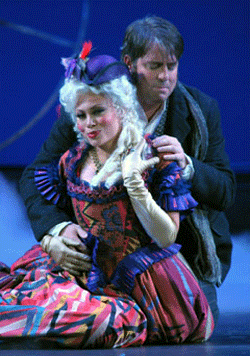 Alyson Cambridge as Giulietta and Matthew Polenzani as Hoffmann
Alyson Cambridge as Giulietta and Matthew Polenzani as Hoffmann
As in comparable productions of Offenbach’s late opera the prologue and first act are performed together. At the start of the prologue in this conception pantomimic gestures show the inebriated Hoffmann being helped from the stage by his Muse, just as Councillor Lindorf assumes his position before a backdrop at the center. Lindorf’s rivalry with Hoffmann is now focused on the diva Stella who currently sings in a local production of Mozart’s Don Giovanni. As Lindorf bribes the diva’s servant to surrender a communication intended for Hoffmann, the Councillor assures that he has the advantage of a devilish spirit with an extended pitch on ”diable.” In opposition to the “poète” Morris concludes his self-declaration with an effectively declaimed “je suis vif.” This scene is effective not only as a motivation for Hoffmann’s relating his amorous adventures but also as a key to the opera’s conclusion when Stella indeed leaves the stage accompanied by Lindorf.
During the remainder of the prologue the scene takes place in Luther’s tavern. The collected male students, portrayed in a large tableau by the Lyric Opera Chorus, are clearly inspired during intermission at the neighboring opera and raise toasts to Stella. Once Hoffmann and Niklausse appear at the tavern, the repartee with the students leads to Hoffmann’s well-known chanson about the dwarf Kleinzach. As Hoffmann describes in his ballad the face of Kleinzach his mind wanders to focus on his love for Stella. In this mixture of musical styles and the subsequent veneration of Stella, Polenzani interspersed a clear sense of legato with lyrical outbursts sung forte (“figure,” “trois âmes dans une seule âme”) and showing exquisite control of pitch. In his final cresting declaration before the close of the prologue Polenzani introduces vocally Hoffmann’s emotional state in preparation for the narratives of the following acts. (“Du bon sens”)
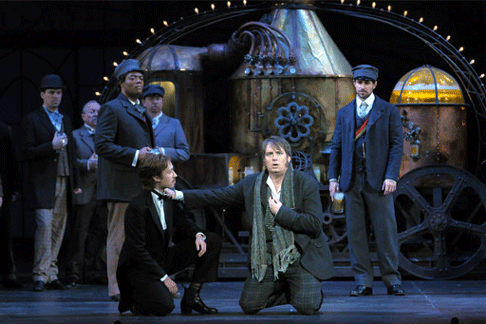 Emily Fons as Nicklausse and Matthew Polenzani as Hoffmann
Emily Fons as Nicklausse and Matthew Polenzani as Hoffmann
In each of these subsequent acts an amorous entanglement leads to hope and disappointment. The female objects of Hoffmann’s infatuation, Olympia, Antonia, and Giulietta, are sung in this production by Anna Christy, Erin Wall, and Alyson Cambridge. As Hoffmann first steals a glance at the mechanical doll Olympia in Act I, Polenzani’s lyrical technique bloomed yet further beyond his singing in the prologue. He sang at times piano with an effective use of diminuendo as he described his devotion to the study of physics primarily as a means to approaching the professor’s daughter Olympia. These lines became even more credible for the persona of Hoffmann as Polenzani’s characterization was delineated with effortless top notes. Before the doll sings her famous aria Niklausse arrives and comments on Hoffmann’s delusion and emotional distraction. Here Ms. Fons sang her first solo piece with lyrical ease and presented an amusing caricature of the doll as she mimicked it both vocally and with her own physically lithe gestures. Hoffmann refuses to heed common sense and listens enraptured to the doll Olympia’s voice. In this role Ms. Christy excelled at combining a bright upper register in her melodic line with skillful coloratura decoration. At the same time she sang in the spirit of the character so that her voice took on the mechanical quality which her body communicated through gestures, as she performed fixed in a rotating movable base. In his response to Olympia’s movements and speech Polenzani depicts Hoffmann lost in his passion while he casts off volleys of lyrical devotion. As Olympia’s identity is finally revealed Polenzani concluded the act together with the chorus in alternating cries of “Un automate” sung forte and with absolute control of pitch.
In Act II the characters Antonia, her father Crespel, and the voice of her deceased mother contribute to Hoffmann’s second involvement. Erin Wall sang a touching rendition of Antonia’s wistful opening romance, “Elle a fui” [“She has flown away”]. Ms. Wall varied her approach so that her softest notes blended fittingly with more dramatic and fully voiced lines. In the role of Crespel bass-baritone Christian Van Horn made a strong impression as Antonia’s protective father. As he implored his weakened child to sing no longer, even the simple phrase “Je t’en prie” [“I beg of you”] was infused by Mr. Van Horn with memorable resonance. When Hoffmann and Niklausse enter on this scene, the servant Frantz — sung her by Rodell Rosel with comic delight — is alone, having just finished a pantominic dance. Hoffmann begs to be admitted to his beloved Antonia’s presence, a meeting which Frantz has been forbidden to allow. In the following series of set pieces the characters reflect on both the role of love and on their own emotions. As one of the highlights of this productions Ms. Fons sang the second aria for Niklausse while she tries to persuade Hoffmann to devote himself to love as art (“Vois sous l’archet frémissant” [“See beneath the quivering bow”]). Fons used her voice with its secure low notes to great effect in expressing the dominant spirit of “l’amour vainqueur,” just as she concluded the aria by drawing on the exciting upper extension of her range. Niklausse makes himself scarce at the reappearance of Antonia who now finally sings together with Hoffmann. In their duet Wall and Polenzani showed refined passagework, their voices moving apart and, again, in unison with emotional commitment. At the entrance of Dr. Miracle, sung by Morris, Crespel expresses great concern for his daughter’s well-being. Ultimately Antonia succumbs to the persuasions of Dr. Miracle and to the voice of her dead mother, sung here with resonance and authority by mezzo-soprano Jamie Barton in her debut at Lyric Opera. When Hoffmann attempts to summon help, his beloved Antonia has already died.
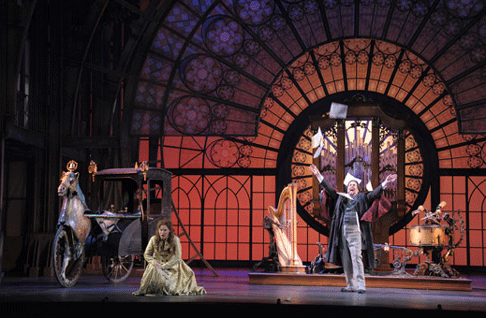 Erin Wall as Antonia and James Morris as Dr Miracle
Erin Wall as Antonia and James Morris as Dr Miracle
The final involvement in the protagonist’s series of adventures carries him to Giulietta’s palazzo in Venice. At the start of the final act she and Niklausse sing the famous barcarolle; in this performance both voices were distinctly audible as though both were woven into the melody. The signature bass aria, “Scintille, diamante,” sung by Dapertutto to tempt Giulietta, was sung by Morris with an attentive sense of line. Ms. Cambridge fulfills well the vocal and dramatic challenges of her role, yet at times her use of vibrato can lead to stylization.
In the epilogue to the opera Hoffmann has finished the narration of his tales and is found, inebriated, together with the Muse. Even though Stella from the prologue now appears for the assignation and leaves in the company of a triumphant Lindorf, the audience presumes that Hoffmann will awaken in the confident realm of Poetry.
Salvatore Calomino
image=http://www.operatoday.com/Hoffmann_Chicago_2011_01.gif image_description=Matthew Polenzani as Hoffmann and Anna Christy as Olympia [Photo by Dan Rest courtesy of Lyric Opera of Chicago] product=yes product_title=Jacques Offenbach: Tales of Hoffmann product_by=Click here for cast and other production information. product_id=Above: Matthew Polenzani as Hoffmann and Anna Christy as OlympiaPhotos by Dan Rest courtesy of Lyric Opera of Chicago
David Alden directs Cavalli’s Ercole Amante for Amsterdam, 2009
It’s taken quite a long time, after all, for Handel to be somewhat regularly performed. So don’t be expecting any time soon for the Ercole Amante of Francesca Cavalli (born 1602) to make it to the Metropolitan at Lincoln Center, the Lyric of Chicago or the War Memorial of San Francisco.
Fortunately, those with either an interest in the beginnings of the operatic artform or simply more catholic tastes can at least avail themselves of the DVD of David Alden’s production, as recorded in January 2009 at the Het Musiektheater Amsterdam. As seen in spectacular Blu-ray, this riotous yet paradoxically respectful production of Cavalli’s opera (to a libretto by Francesco Buti) gives the viewer a sense of the entertainment value of operas that often seem, when performed dully out of a sense of historical accuracy, tediously formal in the extreme. The harmonies rarely stray from the expected, and there sometimes seem to be 10 minutes of recitative for every minute of music. Surely a composer such as Cavalli expected to have the full use of the most modern stage wizardry of his time, and Alden hasn’t denied himself the best of ours either. With the imaginative costumes of Constance Hoffman and the ingenious sets of Paul Steinberg, Alden has put together a show that respects the opera’s most sincere moments while teasing the opera’s titular hero and his less than heroic shenanigans right up to the edges of parody.
Written as part of the marriage celebrations for Louis XIV, Ercole Amante begins with a choral tribute and then effortlessly slips into the story proper. Ercole (Hercules) is a bored husband, infatuated with one Iole, who just happens to be the intended of Ercole’s own son, Hyllo. Deianira, Ercole’s wife, pleads with Gionone (Juno) for help to save her marriage, as Ercole has bargained with Venere (Venus) for assistance in his plot to seduce Iole. When frustrated, Ercole grows so furious he condemns to death his own son. Eventually Hyllo arranges for Ercole to don the infamous poisoned robe, which condemns Ercole to the Underworld — a location to which he adapts rather quickly, finding himself still abele to pursue his amorous dictates there. And so - a happy end for all!
As Alden himself ruminates in one of the bonus features, it’s not clear if composer and librettist counted on the royal party’s good humor or if they never gave a second thought to the less than favorable light the opera casts on the mythological stand-in for the King. As director, Alden plays with this dichotomy by having Luca Pisaroni in the initial scene dressed as Louis XIV, only to change into his wild Ercole persona by use of ridiculous plastic muscle molding, tall platform boots and a pro wrestler’s extravagant wig. Pisaroni is perfect for the role, being handsome enough to play the self-infatuated hero and yet with that wink of self-awareness. Camping it up even more exuberantly are Marlin Miller as the servant of Ercole’s wife and counter-tenor Tim Mead as a page.
Veronica Cangemi as Iole and Anna Maria Panzarella as Deianeira get the show’s most somber moments, and while they’re good, most viewers will be anxious for the wildness to start up again. Anna Bonitatibus’s Juno and Wilke te Brummelstroete as Venere have and are more fun.
Ivor Bolton and the expert Concerto Köln sound a bit clunky in the interposed ballet music of Lully (or is that Lully’s fault?), but the long stretches or recitative stay lively and even colorful in their expert hands.
Besides the sheer beauty of the Blu-Ray picture, Opus Arte deserves kudos for the excellent bonus features, which include a synopsis, cast gallery, filmed interviews with Pisaroni and Johanette Zomer (who takes three minor roles), and a thirty-minute “making of” featurette with fascinating glimpses into rehearsals and costume and set construction. To nitpick, that featurette needlessly repeats some clips from the interviews.
The larger American opera houses might not be ready either for Cavalli’s Monteverdian composition or David Alden’s risk-taking approach, but lovers of creative opera stagings should be thankful Amsterdam put this show on and recorded it. Snap it up.
Chris Mullins
[Editor’s Note: Ercole Amante was performed at the Boston Early Music Festival in June 1999.]
image=http://www.operatoday.com/OABD7050D.gif
image_description=Francesco Cavalli: Ercole amante
product=yes
product_title=Francesco Cavalli (with ballet music by Jean-Baptiste Lully): Ercole Amante
product_by=Ercole: Luca Pisaroni; Iole: Veronica Cangemi; Giunone: Anna Bonitatibus; Illo: Jeremy Ovenden; Deianira: Anna Maria Panzarella; Licco: Marlin Miller; Nettuno / Tevere / Spirit of Eutyro: Umberto Chiummo; Bellezza / Venere: Wilke te Brummelstroete; Cinzia / Pasitea / Spirit of Clerica: Johannette Zomer; Mercurio / Spirit of Laomedonte: Mark Tucker; A Page / Spirit of Bussiride: Tim Mead. Netherlands Opera Chorus. Concerto Köln. Conductor: Ivor Bolton. Stage Director: David Alden. Recorded live from the Het Muziektheater, 2009.
product_id=Opus Arte OABD7050D [Blu-Ray]
price=$48.99
product_url=http://www.arkivmusic.com/classical/album.jsp?album_id=391068
Roméo et Juliette, LA
Though love and gloom permeate Gounod’s Roméo and Juliette — the opera opens with a melancholy choral prologue and ends with a tear provoking death duet — it was love that won the day when the curtain came down at the opera’s November 6th opening performance at the Dorothy Chandler Pavilion. But this was not the love of the young protagonists for each other, rather it was that of the audience for the opera, its principle performers, and its conductor Placido Domingo. The moment the curtain fell, applause overwhelmed the last orchestral sounds. And the instant it rose again to reveal the singers and set, bodies shot forth from their seats as one.
The current production is a revival of the 2005 presentation of the work directed by Ian Judge. As it did six years ago, Roméo and Juliette brought together two young singers at the thresholds of their operatic careers, Georgian soprano, Nino Machaidze, and Italian tenor, Vittorio Grigolo. More about them in a moment.
Shakespeare’s play, shaped for Gounod by librettists Jules Barbier and Michel Carré into five acts that focus exclusively on the lovers, gave the composer abundant opportunity write music filled with love and with dread. When it was produced in Paris in 1867, the work immediately won the hearts of French audiences. Its first Metropolitan Opera performances in 1884 were sung in Italian. Its reappearance in the Met repertory at an 1891 performance in Chicago marked the first time the company sang a French opera in French. It was as quickly a success here as well, and why not? Those early performances featured the De Reszke brothers and Emma Eames.
Who knows what the De Reszkes and Mme. Eames, swathed in their their multilayered costumes would have made of this slick production delivered in two acts, featuring slim young lovers romping in bed half nude, and set nowhere in particular? The essentially unit set with movable sections, is a skeletal iron structure which recalls old Parisian arcades, or the base of Eiffel Tower. However, the set changes were fairly rapid and effective. Costumes were dark and restrained. The beautifully constructed gowns for the First Act ball never lit the scene, perhaps to help us keep us in mind of impending doom. My major grievance relates to the direction after Mercutio’s death. Ian Judge has our hero fighting dirty. After hand to hand pushing and shoving and a brief duel with knives, Romeo suddenly has a gun in his hand and unhesitatingly shoots Tybalt point blank. If you heard someone exclaim. “that’s that not fair,” you were sitting near me.
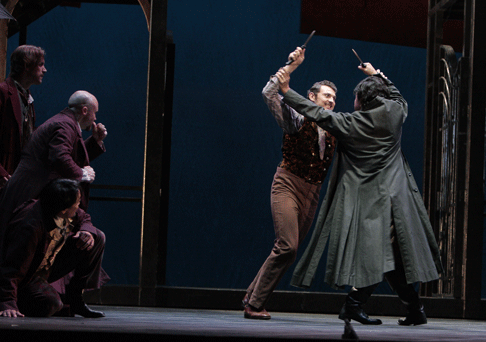 Alexey Sayapin as Tybalt and Museop Kim as Mercutio
Alexey Sayapin as Tybalt and Museop Kim as Mercutio
Neither Machaidze or Grigolo, who was making his LA debut, is new to French opera. The soprano was Juliet in Salzburg in 2008 and in Verona this past July. She and Grigolo performed their roles together in June at La Scala. Grigolo has also sung Hoffmann and scored an enormous success as Des Grieux in his Covent Garden debut.
Machaidze was a charming Juliet, though her voice, noticeably edgier than in her Salzburg Juliet, was occasionally shrill at the top. Grigolo, known in his youth in Italy as il Pavarottini, has a dark robust almost baritonal voice with a gravelly buzz in mid range that opens to a clarion clarity at the top. Slim and handsome, he is also remarkably agile and scaled the gates and ladders keeping him from his beloved with the litheness of a cat burglar.
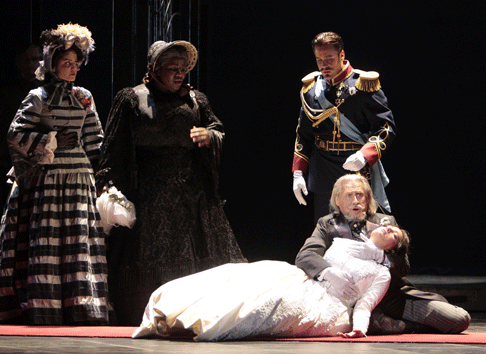 Vladimir Chernov as Capulet and Nino Machaidze as Juliette, with Ronnita Nicole Miller (in black) as Juliette's Nurse, and Daniel Armstrong (at right, in rear) as Count Paris
Vladimir Chernov as Capulet and Nino Machaidze as Juliette, with Ronnita Nicole Miller (in black) as Juliette's Nurse, and Daniel Armstrong (at right, in rear) as Count Paris
Museup Kim as Mercutio and Renée Rapier, making an unexpected LA opera debut as Stephano, were outstanding in this large cast. Vitalij Kowaljow was a sonorous Friar Laurence. Alexey Sayapin debuted as Tybalt. Baritone Vladimir Chernov sang the thankless role of Count Capulet, and Ronnita Nicole Miller had little to sing about as Juliette’s nurse.
Maestro Domingo’s conducting, while responsive to Gounod’s long melodic lines, whether instrumental or vocal, lacked the rhythmic thrust that keeps a repeated waltz beat buoyant. Perhaps his rehearsal time was limited. But no one cared. With the production staff, performers, conductor and chorus on stage, and the energetic Grigolo pulling them forward for yet another bow, all was love Sunday afternoon at the Los Angeles opera.
Estelle Gilson
image=http://www.operatoday.com/RJb3028-1.gif image_description=Nino Machaidze as Juliette and Vittorio Grigolo as Romeo [Photo by Robert Millard for LA Opera] product=yes product_title=Charles Gounod: Roméo et Juliette product_by=Romeo: Vittorio Grigolo; Juliet: Nino Machaidze; Mercutio: Meseup Kim; Friar Laurence: Vitalij Kowaljow; Lord Capulet: Vladimir Chernov; Tybalt: Alexey Sayapin; The Duke of Verona: Philip Cokorinos; Stephano: Renée Rapier; The Nurse: Ronnita Nicole Miller; Gregorio: Michael Dean; Benvolio: Ben Bliss; Count Paris: Daniel Armstrong; Friar John:Erik Anstine. Conductor: Placido Domingo. Director: Ian Judge. Scenic Designer: John Gunter. Costume Designer: Tim Goodchild. Lighting Designer: Nigel Levings. product_id=Above: Nino Machaidze as Juliette and Vittorio Grigolo as RomeoPhotos by Robert Millard for LA Opera
November 6, 2011
November 5, 2011
Lieberson’s Neruda Songs and Theofandis’s Symphony No. 1
Before she had to stop performing as the cancer that took her life progressed, she had the opportunity to debut a major piece by her husband, the composer Peter Lieberson. As a sort of love offering to his wife, composer Lieberson set a series of 5 poems by Pablo Neruda for mezzo and orchestra, and titled the group “Neruda Songs.” Sadly, Peter Lieberson himself succumbed to cancer in April 2011, and so the Atlanta Symphony Orchestra has dedicated to him its new release (on the orchestra’s own label) of “Neruda Songs,” as well as the first symphony of the American composer Christopher Theofanidis.
Kelley O’Connor takes on the formidable task of singing “Neruda Songs” — formidable mostly because of Lorraine Hunt Lieberson’s storied reputation and the emotional context of a composition written for her by her husband, and which Hunt Lieberson only sang a few times before her death. The actual vocal lines of the five poem settings don’t pose much challenge to Ms. O’Connor’s substantial, handsome mezzo instrument. Each of the settings runs to at least 5 minutes, so that the entire performance reaches over 30 minutes in length. Composer Lieberson’s textures are tastefully adorned with Latinate touches, and the vocal line is consistently supported. Neruda’s poems cover a range of moods within their forms, rather like lengthy paragraphs. Lieberson finds some variety, then, within each piece; overall, however, a mood of contrasting sensuality and melancholy dominates. Lieberson might have considered that some have complained that the “Les nuits d’été” of Berlioz, after the energetic opening piece, settles down into an almost claustrophobic monochromatic texture. Not much really distinguishes one Lieberson setting of a Neruda poem from another. Certainly more melodic distinctiveness would be appreciated. Some more individual coloring from Ms. O'Connor would have been of benefit as well. Nevertheless, there is beauty here, and that increasingly rare quality makes “Neruda Songs” special.
As for the disc's opening tracks of the four movements of Christopher Theofandis’s Symphony No. 1, just imagine an impeccably performed and recorded score to a mid-century documentary on American industrial and business might. The excited, quick figures might accompany scenes of busy pedestrian traffic or speedy assembly lines. Occasional dark textures would suggest the ongoing tensions below the surface of the bustling, active pursuit of the American dream. The music would be interesting enough to bring context and meaning to the images, yet not so distinctive as to draw too much attention to itself. But this is not a documentary score - it’s a symphony. By the end of its thirty minutes, one may feel as if hurried along by an over-excited conductor to a not particularly interesting destination.
Speaking of conductors, Robert Spano is a fine one, and his Atlanta Symphony Orchestra sounds fantastic. However, for those most interested in “Neruda Songs,” the recording with Hunt Lieberson singing would be the way to go.
Chris Mullins
image=http://www.operatoday.com/Neruda_Songs_cover_large.png
image_description=Theofandis: Symphony No. 1 & Lieberson: Neruda Songs
product=yes
product_title=Christopher Theofandis: Symphony No. 1; Peter Lieberson: Neruda Songs
product_by=Kelley O’Connor, mezzo-soprano. Atlanta Symphony Orchestra. Conductor: Robert Spano.
product_id=ASO Media CD-1002 [CD]
price=$16.99
product_url=http://www.arkivmusic.com/classical/album.jsp?ordertag=Comprecom7132-572155&album_id=572934
La sonnambula, Royal Opera
However, the wafer-thin text is more than compensated for by the composer’s ravishing score and reams of gorgeous melody.
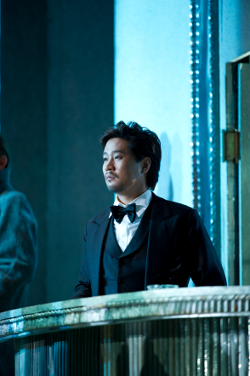 Jihoon Kim as Alessio
Jihoon Kim as Alessio
It’s a simple tale and needs a light touch. Sadly, in this revival of Marco Arturo Marelli’s 2002 production, both the presumptuous direction and Daniel Oren’s sluggish tempi weigh down the proceedings, and the result is narcotic.
Not trusting the music itself to provide depth and insight, Marelli has given the opera a ‘psychological makeover’. Thus, the Swiss village setting is replaced by an Alpine sanatorium (intended, we are told, to suggest the world of Thomas Mann’s The Magic Mountain) where Elvino – no longer a local landlord but a composer – has been undergoing treatment since the traumatic death of his mother. Bellini’s orphaned maid, Amina, to whom Elvino is betrothed, is now a waitress at the sanatorium. So, we have no gentle pastoral woods and byways, rather a sublime mountain-scape panorama, visible through vast atrium windows; sublime, that is, until an avalanche crashes through the windows and ruins the grand piano! And the site of the opera’s only really dramatic event – the narrow bridge over the rushing mill stream upon which the villager’s witness the precarious exploits of the sleepwalking, thereby proving her innocence – is also dispensed with. Instead, Anima has to navigate her way across the wreckage of the piano. Nineteenth-century village yokels are replaced with bustling nurses in crisp uniforms and wheelchair-bound patients sporting modern evening dress. It’s enough to send us all to the asylum.
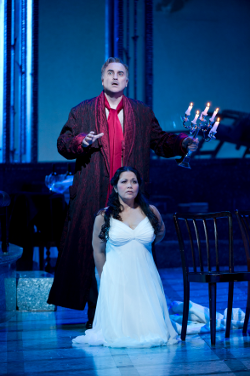 Michele Pertusi as Count Rodolfo and Eglise Gutierrez as Amina
Michele Pertusi as Count Rodolfo and Eglise Gutierrez as Amina
But, bel canto is all about the singing, so perhaps some high-class performances could rescue this production from insanity and inanity? Sadly, our Elvino, Spanish tenor Celso Albelo, could not provide the stature and presence required. While his diction was good and his tone sweet and pure, some incredible high notes and considerable vocal agility could not compensate for a total lack of charm. Albelo’s acting was leaden, and he needs to use his face more expressively to ensure a fully convincing sense of style.
As Amina, Eglise Gutiérrez demonstrated a beautifully tender pianissimo, floating, delicate upper notes, and an expressive vibrato. Crucially, however, her Italian is very poor, and occluded diction destroyed the inherent line of the melodies whose elegance is so intimately rooted in the language. Gutiérrez also adopted an overly fussy approach to the demanding coloratura. The florid passages stretched her technique to its limits, and she simply didn’t have the notes, especially in the final aria, in which she celebrates her lover’s return. Gutiérrez wasn’t helped by Marelli’s decision to bring the curtain down at the very moment she wakes, swap her demure, white nightgown for a plunging, scarlet velvet gown, and force her to stand on a table to deliver this fiendish number. With soloist and conductor wildly adrift, it made for an anticlimactic ending.
The rest of the cast were solid. Elena Xanthoudakis did a good job of conveying Lisa’s bitter jealousy, and mastered the stratospheric pyrotechnics (though why is she costumed as a lusty barmaid?); and as Count Rodolfo, Italian bass-baritone Michele Pertusi was appropriately authoritative and resonant. Elizabeth Sikora sang the role of Teresa, Amina’s foster mother, most impressively, making much of her powerful interjections. Jihoon Kim (Alessio), a Jette Parker Young Artist, and Elliot Goldie (Notary), a member of the ROH chorus, were reliable in their minor roles.
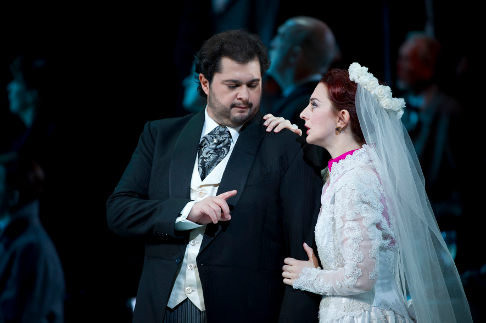 Celso Albelo as Elvino and Elena Xanthoudakis as Lisa
Celso Albelo as Elvino and Elena Xanthoudakis as Lisa
Bellini composed the opera after a holiday in Como, where he admired the landscape and simple pastoral lifestyles of the inhabitants; the folk music he heard inspired him to create the beautiful, quite substantial, choruses which abound in the score. The Royal Opera chorus were a bit ragged, but they did have to endure Marelli’s silly stage antics; the instrumentalists of the ROH orchestra fared better, despite Oren’s uninspiring, tentative guidance.
But, although Marelli’s sweeping scenic designs are pleasing to look at, the production’s psychobabble is pretty unpalatable.
Claire Seymour
image=http://www.operatoday.com/SONNAMBULA%20%C2%A9BC20111029172%20-%20GUTIERREZ%20AS%20AMINA%20%28C%29%20COOPER.png image_description=Eglise Gutiérrez as Amina [Photo by Bill Cooper courtesy of The Royal Opera House] product=yes product_title=Vincenzo Bellini: La sonnambula product_by=Elvino: Celso Albelo; Amina: Eglise Gutiérrez; Lisa: Elena Xanthoudakis; Count Rodolfo: Michele Pertusi; Alessio: Jihoon Kim; Teresa: Elizabeth Sikora; Notary: Elliot Goldie. Director: Marco Arturo Marelli. Conductor: Daniel Oren. Orchestra of the Royal Opera House. Royal Opera Chorus. Set designs: Marco Arturo Marelli. Lighting designs: Marco Arturo Marelli. Costume design: Dagmar Niefind-Marelli. Royal Opera House, Covent Garden, Wednesday, 2nd November 2011. product_id=Above: Eglise Gutiérrez as AminaPhotos by Bill Cooper courtesy of The Royal Opera House
Bluebeard’s Castle, Royal Festival Hall
It was the obvious and fitting choice, both as idea and reality. But first came a far from negligible opening to the concert: a visit from Debussy, albeit in still earlier guise than the composer of Pelléas, and the third of Bartók’s three piano concertos, the soloist again Yefim Bronfman.
Prélude à l’après-midi d’un faune is pretty much universally considered to mark the dawn of twentieth-century music. (The programme note by Malcom Gillies presented Debussy’s work as a candidate, but oddly claimed ‘some date it as late as 1913, with Stravinsky’s Le sacre du printemps.’ No one would gainsay the importance of The Rite of Spring, yet, by the same token, surely no one would date the beginning of twentieth-century music after Schoenberg’s emancipation of the dissonance.) In the hands of Esa-Pekka Salonen — he only picked up a baton later, preferring to mould the music here more freely — Prélude à l’après-midi received a fine performance. Samuel Coles’s opening flute solo was not only not conducted by Salonen; he did not even herald it, leaving Coles to begin in his own time. He did not disappoint; nor did Chris Cowie’s equally fine oboe solo work. Salonen shaped an initially languid reading, soon bathed in the warm glow of the Philharmonia strings. There was certainly a sense of the novelty of form we can all too readily take for granted, but which would point the way not only to later Debussy and to a number of works by Bartók and other composers of his generation, but even to post-war composers such as Boulez, as conductor one of Debussy’s — and Bartók’s — foremost interpreters. Flexibility of tempo proved the key that unlocked malleability of form. Finally came that undefinable, ineffable magic that marks a distinguished performance of this great work.
Such lyricism also informed the opening of the piano concerto, Bronfman presenting it as if in a single breath, foretelling an over-arching melodic approach. The tempo adopted, however, sounded slower than usual; moreover, the general style adopted was more classical, post-Mozartian even, than one often hears. Sometimes I wanted a little more fire from both soloist and orchestra in the first movement: though an interesting reading, it was ultimately a little underwhelming. The cool but not cold dignity with which Bronfman announced his opening statements in the slow movement was striking. Thereafter, the extraordinary night-music — surely the most interesting part of a concerto that does not always show Bartók at his best — was piquant and lively under Salonen. He clearly relished the colours that point back to Ravel but also look forward to Messiaen. A relatively cool classicism paid dividends with the counterpoint of the finale, but elsewhere much sounded a little too relaxed, at times verging on the lethargic. At one point, the pace noticeably picked up, but it seemed more of a correction than an intensification. I have no idea why the lights were dimmed at one point and then turned back up; it was probably a mistake, but it would be nice to think that it was a warning shot to the serried ranks of coughers.
Bluebeard’s Castle was performed in a semi-staged version, directed by Nick Hillel. Bartók’s opera is a strange case, in that in many respects it seems almost made to be performed in concert: its interiority, as heralded by the prologue, may even work better if it compels the listener to direct the work in his head. I am not sure that the production, based upon projections onto a ‘motorised shape’ above the orchestra and a simple enough design around the borders of the stage, added very much, but if it liberated the imagination of some unimaginative souls then it will have done some good and little harm. So far as I could tell, the designs, projections, and lighting all worked as they should.
Woodland film rendered the opening music more than usually Pelléas-like; that seemed to suit Salonen’s strategy too, at this stage characterised by what one might paradoxically call a subdued teeming of orchestral life, rendering contrast of Judit’s viewing the torture chamber all the greater. What we saw here was rather literally representative: some instruments of torture, followed by red for blood — though oddly, the red seemed more redolent of socialist propaganda posters, which, Bartók’s politics notwithstanding, I cannot believe was the intention. Such a colour-based approach might actually have worked better with Schoenberg’s contemporary Die glückliche Hand. On the other hand, visual evocation of diamonds complemented the fantasy so finely painted by the Philharmonia’s harps and celesta. Even then, however, Michelle DeYoung’s facial expressions, let alone her vocalism, had much more to say than any film projection, and still more so in the subsequent case of the flowers. DeYoung offered more than ample compensation for the previously advertised Measha Brueggergosman; hers was a powerfully dramatic and beautifully sung performance, equally alert to the demands of text and melodic line. She was formidable, not in the slightest pathetic; one could readily understand how she had her fateful way. Bluebeard’s defiant pride in the splendours of his kingdom was far better expressed by Sir John Tomlinson’s performance, noble yet wounded, than by turning the lights on and showing a few clouds on the move.
I took a while to be convinced by Salonen’s reading, wondering if the tension was sagging a little in the middle; this was certainly not a razor-sharp Bluebard’s Castle in the manner of Boulez. And yet, matters would become clearer, the greater strategy paying off handsomely, when the cold menace of the increasingly modernist-sounding orchestral palette asserted itself as Judit learned of her predecessors, likewise in the cumulative terror leading up to the final revelation. (DeYoung was superb here too.) The post-Wagnerian orchestral glory of the final climax put me in mind of Schoenberg’s Gurrelieder, but it was the desolation of Tomlinson thereafter that moved most of all. As with so much of the production, the appearance of Judit as an apparition at the back of stage did no violence to the work, but might better have been discarded.
Mark Berry
image=http://www.operatoday.com/Barbebleue.gif image_description=(Gustave Doré, lithographie de Barbe Bleue) product=yes product_title=Claude Debussy — Prélude à l’après-midi d’un faune; Béla Bartók — Piano Concerto no.3; éla Bartók — Bluebeard’s Castle (semi-staged) product_by=Yefim Bronfman (piano); Judit: Michelle DeYoung; Bluebeard: Sir John Tomlinson; Juliet Stevenson (narrator). Director: Nick Hillel (director); Staging: David Edwards; Set designs: Adam Wiltshire; Lighting: David Holmes. Philharmonia Orchestra; Esa-Pekka Salonen (conductor). Royal Festival Hall, London, Thursday 3 November 2011. product_id=Above: Lithograph of Bluebeard by Gustave DoréWily Wexford Stays the Course
This annual Irish celebration of opera’s oddities continues to confound all typical safe season planning, yet it succeeds, and brilliantly. The reasons are many. There are those of us who are starved for anything — well, almost anything — that is not another Così or Carmen or Figaro, especially when they are so frequently destroyed these days by self-indulgent directorial concepts. Wexford has not only nurtured a well-deserved reputation for choosing wisely, and with a trusted sense of adventure, but also produces these rarities with loving care, featuring talented star-singers-on-the-verge, and handsome, sensible productions that actually (gasp) tell the story (were you seated?). That alone sets it remarkably apart from 80% of what is on view on European stages, including most higher ticket festivals.
But best of all, it allows the vast majority of us to come to the shows with a real sense of discovery, an anticipation of spontaneity of musical experience, and with no other singers/orchestras in our ears. This makes the exposure especially important and fruitful for the young (and young-ish) soloists, since they are not being compared to Beverly or Placido or Sam or Regine or the Vienna Phil, who never recorded nor performed these parts. (At the first performance I attended, a woman in front of me turned around and asked “Have you heard this opera?” And I could honestly reply, “I don’t think anyone has!” When is the last time you could say that in a opera house…?)
Ambroise Thomas is well known for his tunefully grandiose, if dramatically flawed pieces Hamlet and Mignon, with their oft-excerpted set pieces well represented on recital discs. But Thomas also penned a delectably effervescent comedy La Cour de Célimène that, if this mounting were any indication, deserves much wider exposure. From the downbeat, the orchestra under Carlos Izcaray set the bar very high indeed with a glowing, breathless prelude that was not only characterized by virtuosic playing from the winds (executing a manic noodling that was like “Flight of the Bumble Bee” on Red Bull), but also rich playing from the banks of strings. Maestro Izcaray displayed a fine command of the comic pacing and the overall propulsion of the piece, and he elicited a beautifully filigreed succession of instrumental details that imparted substantial delight.
The central role of the Countess was authoritatively assumed by the drop-dead-beautiful blond Irish soprano Claudia Boyle. Whatever “star quality” is, she has enough left over to bottle it and sell it. Vocally, Ms. Boyle’s instrument recalled a young, vibrant June Anderson with clearer diction. The top is gleaming, the coloratura was dispatched with breathtaking agility, and the mid and lower ranges were creamy enough to churn a pound of Kerrygold. This is a poised, well-schooled singer on the verge of international acclaim. She soon will undertake Cunegonde in Rome and her showpiece aria in Act Two gave a nod to “Candide” with a wacky, deftly timed sequence where the diva was dressed in an eye-popping white gown, and then accessorized with extravagant Bling. The high-flying vocal riffs were so similar to “Glitter and Be Gay” as to be uncanny. (Dyasuppose Lenny knew this opera?) Claudia Boyle. Watch for her.
Claudia was well matched by the Baroness, securely sung by Nathalie Paulin, who is possessed of a haunting, softly-grained soprano that is by turns warmly sympathetic and potently aggressive as required. She partnered Ms. Boyle flawlessly as the two meandered in extended passages of melismatic thirds that were faultlessly tuned and wonderfully coordinated. Luigi Boccia’s still-developing tenor started off the night a bit like the Wexford weather: cloudy with a chance of strain. But he came back in Act II and regaled us with a clear, ringing lyric that displayed not only good promise, but real accomplishment. I would welcome hearing him again soon. John Molloy’s Commander of Beaupré was charismatically sung, albeit with a somewhat dry, open tone that threatened to spread in the upper reaches. Some of this was attributable to his over the top approach, which it must be admitted capitalized on his considerable stage savvy. In Act I especially, his spoken lines might have benefitted by dialing down the volume knob, since much of what he orated seemed self consciously enclosed by quotation marks. Mr. Molloy found his stride in Act II where his declamations belonged more to the heightened style of the Comédie-Française than in the unamplified carnival barker of the first half; and where his singing rolled forth to produce some outstanding phrasings.
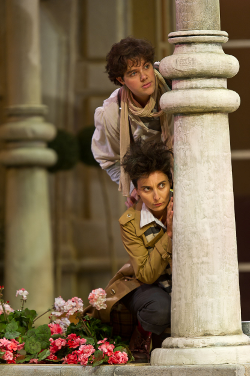 Scene from Gianni Di Parigi
Scene from Gianni Di Parigi
The physical production as imagined by set and costume designer Paul Edwards was a visual delight. Suggesting the skewed machinations of the plot, the entire stage was slightly raked from right to left, with a slanted gold border framing the playing space, and a black and white period etching on the scrim curtain. A text in French proclaimed that the depicted noblewoman reigns over all hearts. When the scrim flies, it reveals a verdant, stylized green semi-circle of six arbors with a pink topiary heart-pierced-by-an-arrow in a planter stage center. The floor of alternating black and white marble squares in concentric circles was topped by a tromp l’oeil ceiling to complete a most elegant playing space. For Act Two, the archways were filled with mirrored biparting doors, and the heart gave way to a huge white round tufted settee. Mr. Edwards’ costumes were sumptuous and character-specific, including the twelve suitors in a riot of jewel-toned waistcoats. Ms. Boyle could hardly have been dressed to better advantage with Act I’s lush deep rose gown replaced by a dazzling white version in Two. The extravagant wigs and make-up were similarly exemplary. One caveat about the tilted picture is that the audience eventually tilted, too, lining up our necks with the picture!
Director Steve Barlow presented varied stage pictures and devised meaningful movement for his troupe. Indeed, he excelled at drawing forth personalized performances from each character, and did much to delineate the suitors. When they first appear singly, each took the stage with a definite point of view, and the ensemble sustained this throughout the night. The team crafted a spectacular star entrance for the Countess who flies in on a love seat suspended by ropes of flowers (the seat belt, too!), with a steady rain of pink petals from on high. She ascends half-way up at Act’s end to open a fan that announces Entr’acte. Act Two starts with a flurry of large pink petals, so big they might hurt, to underscore the complications that the pursuits have incurred. Although the piece does suffer from a sameness of plot twists, Mr. Barlow kept the journey fresh and inventive with inspired business. The nutty sword fight between the tenor and bass was a silly shadow screen effect on the front scrim that mined every titter of humor from that convention; and the maid’s gathering of the pile of roses at the Countess’ command was a brilliant goof. Having scooped the bouquets and hefted them up off the floor, she pauses a moment, and instead of lovingly taking them off with her, she suddenly and violently pitches them in disgust through the fourth wall onto the apron! Startling and hilarious.
The other comic opera, Donizetti’s Gianni di Parigi, was just as professionally staged, if a mite more challenging. For the opus is one long sustained joke that finds the Dauphin (in disguise as Gianni) commandeering (buying) an inn, barring it from use as arranged by the Princesse of Navarre and her party, who are traveling to Paris for her to be wed to …the Dauphin. Left to the mercy of Gianni’s hospitality, the heroine accedes that he is in control of the situation, fully knowing (nyuk nyuk) that he is her betrothed. Now, sustain this skeletal plot description for two hours and you will sense the pitfalls. Happily, the work contains some worthy music that was winningly performed.
If director Federico Grazzini did not offer the fresh kookiness that was evident in the Thomas, he nevertheless drew on a reliable, clean, and utterly workable staging tradition. Crowd management was effective and well motivated, and the parade of repetitive eavesdropping scenes and largely decorative arias were deftly handled. The chorus (singing splendidly during the entire Festival under Gavin Carr’s leadership), were fleet of foot, consistent of focus, and proved themselves to be fast change experts. (The dressers did yeoman work backstage). Tiziano Santi provided an expansive, handsome, welcoming hotel porch and garden that was a joy to inhabit for the evening. Valeria Donata Bettella struck just the right note with her playful costumes.
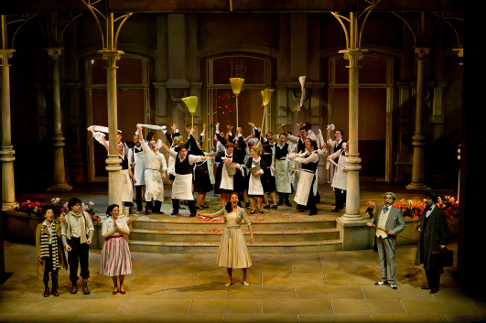 Full cast of Gianni Di Parigi
Full cast of Gianni Di Parigi
Zuzana Markova certainly gave an assured account of the Princess, coolly elegant, utterly composed, and technically accomplished. What her pleasing lyric voice may lack in individual timbre it makes up for with seamless production, and consistent security above the staff. Her stratospheric outbursts ‘in alt’ had a laser-like intensity. Edgardo Rocha brings a good resume and even better intentions to the title role, and he has an engagingly sweet voice, slender but pointed, and very well deployed in heartfelt utterances of love and/or despair. I would urge him to resist pressing the voice up to its very limit on passionate high notes, for we hold our breath wondering if he will cross the line. Edgardo is not (yet) JDF. Or Lawrence Brownlee. And that’s okay, because Mr. Rocha has many assets that are uniquely his own, including a rumpled boyish appeal, and a warm demeanor. I would hope that he pulls back just a little, and allows his voice to find its natural path, which might yield even more impressive results.
Alessandro Spina’s robust bass was a definite highlight as a wiry Pedrigo, and his seasoned buffo performing skills provided welcome diversion. He was a fine foil for the Siniscalco of Alessandro Luongo whose baritone was refined if a bit more diffuse. The pair relished every moment of their duet, reminiscent of the great Pasquale showstopper. Fiona Murphy sang a limpid, wonderfully sensitive Lorezza, and she contributed mightily to the strength of the ensembles. The crowd favorite may have been diminutive Lucia Cirillo as Oliviero, whose sassy, meaty mezzo sizzled through the house at one moment and then moved our hearts the next with a plangently sung, almost sotto voce, arioso.
While the audience gave conductor Giacomo Sagripanti a spirited ovation, I found his leadership inconsistent. He got idiomatic, sparkling playing from his pit, it’s true, but he also seemed to mis-cue on occasion, with a (probably embarrassed) player tooting or bowing at not quite the right moment. For me, he did not always live the music with the soloists, and they did not always land cleanly together on phrase resolutions. And I have to report that he drove the rapid patter in both the afore-mentioned male duet as well as the soprano-tenor duet just past the comfort point, with the singers gamely, but barely, keeping up. The handsome Signor is young, he is talented, and he is self-assured, so now let’s see if he can hone his ‘collaborative’ skill set.
If there were one reason to venture to Wexford this year, it would be to experience the powerhouse performance of Maria by Roman Statkowski. I will forgive you for asking “what,” “by who?” for this work is virtually unknown outside of the composer’s native Poland. Some enterprising company should take up its cause (Santa Fe? Bard?) for it is a thrill-inducing gem. From the first dramatic outburst issuing forth from the pit, we were mesmerized, by the Straussian orchestral effects, by the musical nods to Prokovief and Shostakovich, by the heroic vocal writing, by the bone-chilling production, and by the tremendous musical performance worthy of any world stage.
Under Tomasz Tokarczyk’s baton, the awesome collection of musicians outdid themselves, playing with brio, depth, and attention to detail. The moody piece seemed to fit this Irish band like a glove and the shifting moods and modulations of the (estranged) love duet were evocative and romantic. I must confess, as good as they were, I thought how thrilling it might be to hear the Vienna or Met pit take on this Herculean score, but for right now this was playing of the highest order. When the Maestro was called on stage for his tumultuous reception, it was almost shocking to discover him to be quite slight of stature, for he so firmly inspired such magnificent, over-sized music-making. Bravo, Mr. Tokarczyk. Bravi tutti.
The hapless Maria of the title was strongly sung by Dana Masiero. Perhaps too strongly. Ms. Masiero has a decidedly full soprano with spinto leanings and a generous womanly vibrato. She has had success with Puccini and Verdi roles. And she is an assured presence on stage, well acquainted with sustained gestures that are part of a diva’s bag of tricks. However, the lesser-if-not-lower class girl is here more Jenufa than Tosca; more Katja than Aida. Everything about Dana’s performance was polished and first rate, it was just grander than the part demands. As her love interest, the hapless Count’s son Waclaw, tenor Rafal Bartminksi was giving ‘the’ performance of this or many another festival. Tall and lanky with a youthful face and moppet of sandy hair, he didn’t so much impersonate as become the unlucky loser. When Mr. Bartminski sang with melting beauty and caressed a phrase, you pegged him as a pre-eminent Mozartean. Then when he pinned you in your seat with an orchestra-riding, Vickers-like Heldentenor B-flat, you thought (as the goose bumps rise): where the hell could that have come from? His technique seems secure, his production free, his forte passages unforced, his sense of arching line well judged, his stamina amazing. If he keeps it all together, this is a major talent.
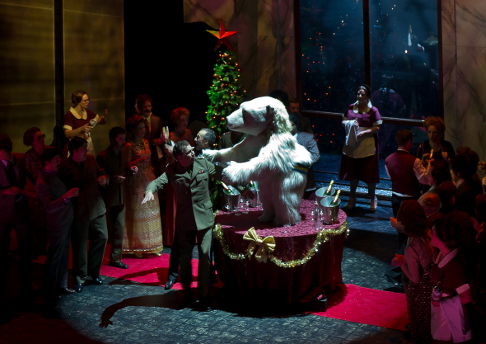 Ballroom scene from Maria
Ballroom scene from Maria
As his father Count Palatine, Krzysztof Szumanski showed off a dark bass and favored us with sinuously malevolent phrases that drove the plot. Conversely, Adam Kruszewski used his pliable, rich-voiced Governor as a perfect, sympathetic foil to the Count. Excellent casting choices, which included the moving, mysterious Waif from Eleanor Jane Greenwood who scored in both of her vital but brief scenes. The young ensemble singers were key to the success and quality of the Festival, and to single out but a few memorable achievements: Marci Gelsa made for a powerful Cavalry Captain; Jamie Rock scored in his moment as a Drunken Nobleman; Byron Jackson made a fine impression as Zmora; and Thomas Faulkner sang well as the Masked Guard.
The production team made a bold, effective choice to update the story, telescoping the end of World War Two, the onset of communism, and Glasnost/Solidarity. This provided a most apt environment to frame the struggles and Big Ideas of the piece. And it sparked a field day for its designers. First and foremost, rarely has video projection been used as effectively as here, as created by designer Andrzej Goulding. He has devised an ever evolving environment, chockfull of resonant images that are still highly charged for us emotionally. And Goulding has provided a recurring video snowstorm that unifies the entire piece. James Macnamara has dsigned multiple, Soviet Bloc settings that are suggestive but not slavishly architectural, allowing for fluid movement from an apparatchik’s office to a ceremonial ballroom; to a dreary, spooky factory yard with an old construction building as residence for Maria and her father, and a disused merry-go-round that once was a playground for the family housing. Fabio Toblini provided a full parade of 60’s fashion for the elite, and depressingly correct lower class attire for the working proletariat. Here, as with the other two operas, Declan Randall proved to be a company treasure with another masterful lighting design full of well-calculated effects, sensitively cued.
Much of the evening’s success must rest with director Michael Gieleta who wrung out every bit of theatricality and melodrama to be found in the piece. The character relationships were uncommonly clear, and their interaction was meaningful, being grounded in the text and music. Maria’s murder was well judged and its simple stagecraft was powerful and direct. Having the privileged ballroom revelers dance and boogie as if to a Tarantella at the frenzied end of Act One, and then having them suddenly become aware that they literally have the blood of the commoners on their hands, held out to us and displayed as they stagger to the apron, was a most powerful symbol. The one moment that I would invite Mr. Gieleta to polish was the reunion scene between Waclaw and Maria. It owes a debt to the recognition Scene in “Elektra” when the heroine realizes he has returned after an inexplicable, long absence, and she hurls his name over a thundering orchestra which then pulls back in volume and mood. The moment and re-connection of the two characters lost its truthful way for about five minutes. But this is a small bit of carping indeed, and we owe Wexford a debt of gratitude for its astonishing, lovingly staged revelation of Maria.
The Festival is not just housed in the magnificent new opera house, but also in other venues in the forms of daytime concerts, recitals, and yes, more opera. On the only misty afternoon of my stay, I took advantage of the ShortWorks program at White’s Hotel and enjoyed a winning dose of Double Trouble, a very effective pairing of Menotti’s The Telephone and Bernstein’s Trouble in Tahiti. Although I knew them both from recordings I had unbelievably never seen them performed before, and well, Lenny and GC, I think you have some talent, since they certainly both still hold the stage. These were not performed with orchestra but really, when you have a Music Director/Pianist the caliber of Adam Burnette, you almost don’t notice since he coaxed such nuanced, sensitive, and dynamic sound from the keyboard. The colorful unit set design by Kate Guinness was very functional, the set pieces well chosen and fluidly moved by well-rehearsed cast members. Ms. Guinness’s costumes were also marvelously apt and served to really establish the characters. David Studdard’s lighting, with very limited resources, was clever and effective. Michael Schell used the constraints of the “found space” as an advantage, and devised ingenious solutions and well considered use of the playing area.
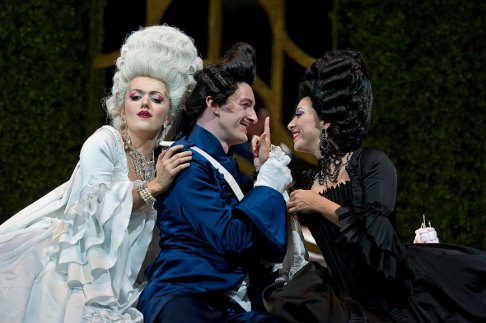 Claudia Boyle as La Comtesse, Nathalie Paulin as La Baronne and John Molloy as Le Commandeur de Beaupré (La cour de Céliméne)
Claudia Boyle as La Comtesse, Nathalie Paulin as La Baronne and John Molloy as Le Commandeur de Beaupré (La cour de Céliméne)
Soubrette Laurie Ashworth gave a solid, daffily oblivious, cheerily chirping turn as Lucy. In the less well written role of Ben, Byron Jackson made good on his promise the night before in Maria and used his throbbing baritone to good effect. Although it is widely accepted in English pronunciation, I wondered if his trilled “r’s” were really necessary in this small venue. In the Bernstein, the jazz trio blended seamlessly when called for, but each singer also displayed real panache and distinctive personality when allowed: Hannah Sawle (suave mezzo with a nice, unforced belt voice); Christopher Carroll (smooth lyric tenor); and Jamie Rock (strong lyric baritone). Glam mezzo Martha Bredi had all the vocal and dramatic goods to effectively deliver the afternoon’s best known scena, “What a Movie!” and Toby Girling was truly affecting as Ben, acting well and investing his appealing baritone with palpable heart and meaning.
Wexford Festival Opera has not only maintained, but has greatly refined its mission of providing lesser (or little) known pieces in top flight productions with tomorrow’s stars. I promise you, there is no other festival like it in the world. All serious opera-goers should rejoice in its accomplishment. The 2012 Season (24 Oct - 4 Nov) promises to carry on the tradition with Le Roi Malgré Lui (Chabrier), A Village Romeo and Juliet (Delius), and Francesca da Rimini (Mercadante).
James Sohre
La Cour de Célimène by Ambroise Thomas
Countess: Claudia Boyle; Baroness: Nathalie Paulin; Commander of Beaupré: John
Molloy; Cavalier of Mérac: Luigi Boccia; Bretonne: Claire Egan. Conductor:
Carlos Izcaray. Director: Stephen Barlow. Set and Costume Design: Paul Edwards.
Lighting Design: Declan Randall. Chorus Master: Gavin Carr.
Maria by Roman Statkowski
Maria: Daria Masiero; Waclaw: Rafal Bartminski; District Governor: Adam
Kruszewski; Count Palatine: Krzysztof Szumanski; Palatine’s Envoy: Daniel
Joy; Waif: Eleanor Jean Greenwood; Zmora: Byron Jackson; Cavalry Captain:
Marcin Gelsa; Drunken Nobleman: Jamie Rock; Masked Guard: Thomas Faulkner.
Conductor: Tomasz Tokarczyk. Director: Michael Gieleta. Set Deign: James
Macnamara. Costume Design: Fabio Toblini. Lighting Design: Declan Randall.
Video Design: Andrzej Goulding. Choreography: Edel Quinlan. Chorus Master:
Gavin Carr.
Gianni di Parigi by Gaetano Donizetti
Princess of Navarre: Zuzana Markova; Gran Siniscalco: Alessandro Luongo; Gianni
di Parigi: Edgardo Rocha; Pedrigo: Alessandro Spina; Lorezza: Fiona Murphy;
Oliviero: Lucia Cirillo; Conductor: Giacomo Sagripanti. Director: Federico
Grazzini. Set Design: Tiziano Santi. Costume Design: Valeria Donata Bettella.
Lighting Design: Declan Randall. Chorus Master: Gavin Carr.
Double Trouble: The Telephone (or
‘L’Amour à Trois’) by Gian Carlo Menotti and
Trouble in Tahiti by Leonard Bernstein
Lucy: Laurie Ashworth; Ben: Byron Jackson; Sam: Toby Girling; Dinah: Martha
Bredin; 1st Trio Member: Hannah Sawle; 2nd Trio Member: Christopher Carroll;
3rd Trio Member: Jamie Rock. Music Director: Adam Burnette. Director: Michael
Shell. Set and Costume Design: Kate Guinness. Lighting Design: David
Stuttard.
Photos courtesy of Wexford Opera Festival
November 4, 2011
Heart of Darkness, Royal Opera
The Turn of the Screw and Heart of Darkness might seem to belong in this category; but, as Britten so supremely demonstrated in the case of Henry James’ novella, and Tarik O’Regan has skilfully shown in this adaptation of Joseph Conrad’s tale of exploration, obsession and morality, we would be wrong to make such assumptions. Indeed, Conrad himself described the novella in musical terms in his 1917 Preface: “… like another art altogether. That sombre theme had to be given a sinister resonance, a tonality of its own, a continued vibration that, I hoped, would hang in the air and dwell on the ear after the last note had been struck.”
Echoes of Britten loom large in Tarek’s new opera, performed in the Linbury Studio at the Royal Opera House by Opera East, directed inventively by Edward Dick. The (almost) exclusively male cast, the ship-bound setting, the exposure of dark, compelling psychological forces, the exploration of guilt and silence, all recall Britten’s Billy Budd. Marlow’s soul-searching self-interrogation parallels the moral dilemmas and regret of Captain Vere. Similarly, O’Regan’s musical means — a fluent melodic idiom which serves the text effectively and expressively, an eclectic chamber instrumentation, the musical articulation and intimation of mysteries and the ‘unknown’ — are reminiscent of Britten’s style and techniques.
Drawing the economical but resonant text exclusively from Conrad’s own words (both the novella and his diaries), librettist Tom Phillips has retained the original device of relating events through a ‘frame’, as Marlow reveals his history to his fellow seafarers as they wait aboard ship for a mist to clear from the Thames and allow them to continue their homeward journey. But, Phillips has also provided a second ‘frame’ to envelope the first, in which Marlow visit’s Kurtz’s European fiancée, the opening brief fragment remaining obscure until the meaning of Marlow’s mysterious encounter is revealed at the close.
Robert Innes Hopkins’ stage designs and Rick Fisher’s lighting skilfully allow for slick, convincing shift between times and locations, the Thames estuary and the Central African interior. The predominantly darkened set is occasionally illuminated or washed by a disturbing glow, as when, for example, a luminous miasma hovers eerily and ominously above the stage. The water-borne platform of the ship’s deck rolls and lurches to the lapping rhythms of the river.
As was the case with The Turn of the Screw, O’Regan and Phillips have had both to distil and clarify some of the ambiguities of the literary text, to achieve a coherent form suited for dramatic presentation, and to create space for musical presentation and expansion of the rich inferences of the original.
O’Regan’s varied and atmospheric orchestration certainly achieves the latter. Avoiding clichés but making use of some sufficiently familiar melodical and timbral associations, the composer has skilfully evoked place and ambience with precision and impact. Harp, celeste, guitar and energetic percussion underscore the heat and mystery of the Congolese jungle. In contrast, the arrival of the long-awaited “rivets” which will enable Marlow and his shipmates to continue their journey to the heart of the interior heralds a riotous dance of glee, a momentary alleviation of the oppressive spirit of anxiety and danger which overshadows their passage.
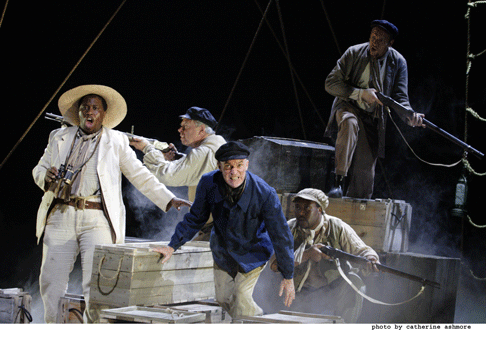 The cast of The Heart of Darkness [Photo by Catherine Ashmore courtesy of the Royal Opera House]
The cast of The Heart of Darkness [Photo by Catherine Ashmore courtesy of the Royal Opera House]
The handling of form and pace is superb. Marlow’s journey is swift but the composer allows for moments of repose and reflection, effortlessly and almost imperceptibly altering tempo and metre, register and colour. The complicated score was impressively conducted by Oliver Gooch, who was in full command of the musico-dramatic structure of the work, and alert to the emotional ‘weight’ of significant moments. Gooch was superbly served by the instrumentalists of Chroma, whose accuracy, energy and mastery of various idioms, and sensitivity to the singers and the text, was exemplary.
As Marlow, tenor Alan Oke had the lion’s share of the work, and gave a powerful, moving performance. His diction was clear and eloquent, and he employed contrasting tones to convey the ambivalence of his action and his own moral evaluation of them. Oke was supported by a fine cast. Bass Donald Maxwell was a suspicious-looking Doctor, and a buoyant, lively Boilermaker; Jaewoo Kim’s Harlequin was athletic and intriguing, both physically and orally. A committed performance by Danish bass Morten Lassenius Kramp depicted the full horror and despair of Kurtz’s disintegration. The soaring, wordless vocalisation of Gwenneth-Ann Jeffers, as the River Woman who mournfully laments Kurtz’s passing, provided a welcome timbral counterpart to the lower registers of the male voices, and conjured an ambience of suffering, extremity and the limits of human endurance.
The opera builds to a powerful climactic scene: Kurtz’s death — inarticulate, raving, disillusioned — brings Marlow to the realisation that, “His intelligence was perfectly clear, but his soul was mad”. Here, the vocal expressiveness of O’Regan’s melodic line was expertly utilised by Oke to reveal Marlow’s painful recognition of human failing.
A final frame reveals the significance and meaning of the opening ‘frame’: Marlow is unable to reveal the truth of Kurtz’s ultimate horrific vision to the latter’s fiancée — it is simply “too dark”. This chilling scene is followed by what is perhaps the opera’s only structural weakness; for Marlow commences a short ‘explanation’, offered to his crew and to the audience, of the role played by the exploiting colonialists in Kurtz’s tragedy, explication which adds a slightly distracting ‘footnote’ (highlighting the colonial theme of the original) to what has up until that point been a single-focused “musical psychodrama”, as the creators themselves describe the work.
But that is a minor observation. This is a thrilling new work, in a brilliantly realised production. I hope I get the opportunity to see it again soon.
Claire Seymour
image=http://www.operatoday.com/Joseph_Conrad.gif image_description=Joseph Conrad product=yes product_title=Tarik O’Regan: Heart of Darkness product_by=Marlow: Alan Oke; Kurtz: Morten Lassenius Kramp; Woman of the River/Fiancée: Gwenneth-Ann Jeffers; Harlequin: Jaewoo Kim; Doctor/Boilermaker: Donald Maxwell; Director of the Thames Boat: Njabulo Madlala; Manager/Secretary: Sipho Fubesi; Chief Accountant/Helmsman: Paul Hopwood. Conductor: Oliver Gooch.Chroma Ensemble. Opera East Productions. Director: Edward Dick. Designer: Robert Innes Hopkins. Lighting Designer: Rick Fisher. Linbury Studio, Royal Opera House, London, Tuesday, 1st November 2011. product_id=Above: Joseph ConradNovember 1, 2011
Anna Bolena, Metropolitan Opera
Giving seven performances of Donizetti’s Anna Bolena, in its first Met outing, with internationally glamorous Anna Netrebko followed by three more (not just one or two!) with a very different singer, rising bel canto star Angela Meade, a local girl with a large local following, has been a very happy choice. For one thing, this is a huge role in a little-known opera; it was insurance for the house to have a cover available, and any soprano capable of singing it well deserves a few chances to show what she can do. I’d heard what Netrebko’s version on the air from Vienna last spring, then by way of the Met web site’s free player on opening night here, and again by way of the HDTV movie theater showing at the BAMRose cinema in Brooklyn. On October 24, I attended Meade’s second Bolena in the house.
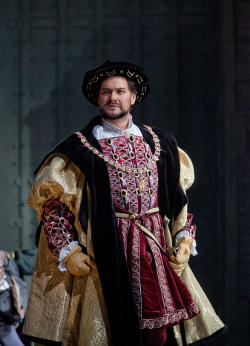 Ildar Abdrazakov as Enrico
Ildar Abdrazakov as Enrico
Anna Bolena is perhaps the longest prima donna role in any of Donizetti’s operas—and Anna may be his longest work, fully four hours of music if uncut. It was his first hit in Milan (and, later, beyond the Alps), composed in 1830 after a busy decade in Naples, the capital of a different country at that time. He was determined to make an impression with a vehicle for Milan’s reigning singing actress, Giuditta Pasta. The role may lack the emotional spectrum of Bellini’s Norma, composed for the same singer a year later, but she had plenty to do: a double aria sortita, three highly charged duets (with mezzo, tenor and bass), a passionate trio, two full-scale ensembles, and a famous mad scene that ranges elaborately from pathos to rage. Canary coloraturas—this is not for you.
Overheard all about me in the crowd at the Met and at BAM: “This is such a wonderful opera! With such lovely music! Why has the Met never done it before?” If beautiful music and thrilling vocal drama were all that mattered, the Met has only scraped the surface of the nineteenth century’s possibilities, to say nothing of the eighteenth. In part, it’s a matter of fashion. By the time the Met was built, in 1883, dramatic coloratura vehicles were largely a thing of the past. Of Donizetti’s dozens of successful serious operas, only Lucia survived the stylistic change wrought by Verdi and his successors. Callas brought Anna Bolena back from a century’s obscurity in 1957, but she didn’t sing it often, bequeathing the La Scala production to Leyla Gencer. Caballé sang it just once, and acknowledged a rare failure. Sutherland did not tackle it till she was fifty-seven, far too late to make much of the character. Souliotis recorded it, unevenly as usual, but the recording has its partisans. Sills was New York’s Anna: she triumphed in it for a couple of seasons at the City Opera. Krassimira Stoyanova sang Bolena in a drastically cut concert version with Eve Queler’s Opera Orchestra of New York, and was spectacular in the raging fioritura of the “Giudici” scene—the opera came to life for me then as it never had before. She has not sung it anywhere since, perhaps because she lacks secure high notes: Anna ranges all over the scale. You might say she sings her head off.
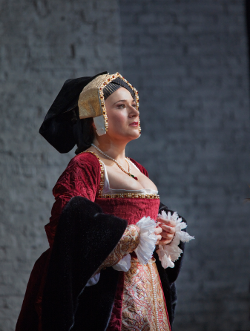 Ekaterina Gubanova as Giovanna Seymour
Ekaterina Gubanova as Giovanna Seymour
Everyone remembers that Henry VIII wished to be rid of his first wife, Catherine of Aragon, who had not borne him a son, and that the pope’s unwillingness to grant an annulment drove Henry, an opponent of Luther’s Reformation, to renounce papal supremacy. His passion for Anne Boleyn, which was quite genuine (their love letters have been set to music), was at first incidental to his wish to marry anyone capable of giving him a male heir, but Anne, in addition, was part of the clique forwarding Protestant reform. She was a highly attractive, sharp-tongued, neurotic femme fatale, capable of inspiring both passion and hatred, and when her sons, like Catherine’s, did not live (her daughter Elizabeth, of course, did), Henry turned against her brutally. She was accused of assorted adulteries (high treason for a queen), and sent to the block, to her great surprise (no one had beheaded a queen before). That was in 1536. In Italy three centuries later no one gave a hang about Protestant disputes, and the opera boils down to a marriage gone bad and the trap laid by a brutal husband to catch his wife in flagrante duetto. That’s an easy story for any audience to grasp, as is the prima donna unjustly done to death.
Whether Anna ever really loved Henry and if she still does are questions never mentioned in the libretto; this deprives her of a necessary dimension of tragedy (if she did), or exculpates him (if she did not). Perhaps Donizetti felt he had enough plot to set without facing such a question.
David McVicar’s production is large and dark, as if one look at the five-story-high stage of the Met overwhelmed any sense of proportion. Getting the proper atmosphere should not require such “authenticity.” I missed the light touch Ming Cho Lee brought to the City Opera’s Tudor trilogy: A tapestry down from the flies, a central playing area, a grand fireplace, an occasional throne or dungeon chamber, and there we had it: Instant Tudor! At the Met, Robert Jones’s sets look like the drearier rooms in a manor of the period—not the ornate court rooms!—and they are two or three times too high. They are vaguely historical backdrops, but they lack the color of backdrops. Jenny Tiramani’s costumes, too, may well be in period—I do not challenge that they are—but surely not everyone wore black and gray at a brilliant Renaissance court. The chorus, homogenous enough in Donizetti anyway, becomes a singing wainscot. The hunting forest, too, is gray, and the triple-arched corridor of the last act is simple to the point of self-effacing. Only the appearance of the swordsman at the end, Anna’s fate, seems to attempt a visual coup, and the music ignores him, focused by this point entirely on Anna.
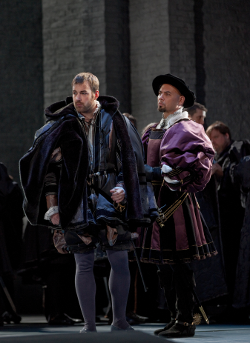 Stephen Costello as Lord Percy and Keith Miller as Lord Rochefort
Stephen Costello as Lord Percy and Keith Miller as Lord Rochefort
Anna Netrebko has a large and beautiful voice and can be a most affecting actress, but her voice never seems as at home in Italian music as it did when she sang Russian roles like Ludmila and Natasha. In bel canto, she suffers from imperfect agility and a nasal delivery that does not breathe with the music. The greatest bel canto artists school themselves to breathe in exactly the phrases the composers wrote, so that the melody, ornamented or not, becomes a melodious kind of speech, a vernacular poetry. I suspect Russian singers are trained to breathe differently in their own ancient church-based tradition, and very few of them escape it when singing western music, however beautiful the instrument itself. This is my problem with Galina Vishnevskaya’s Puccini, Dmitri Hvorostovsky’s Verdi and Ekaterina Gubanova’s Donizetti. A few Russian divas, such as Olga Borodina and Ljuba Petrova, seem to have surmounted this awkwardness; Netrebko has not. Too, I find her affect too heavy for Bolena, and on the Opening Night broadcast she was under pitch for much of the long night. This may be attributed to the strenuous rehearsal process and first-night jitters: By the HDTV broadcast nearly three weeks later, she was on pitch throughout, her voice in charge and easily produced. She has always been a fine actress, and a queen in distress suits her very well. Though I enjoyed her Vienna broadcasts of Bellini’s Giulietta and Amina very much, as sheer, lovely sound, my personal preference would be to hear this sensuous instrument in a more rewarding vehicle, such as Puccini’s Manon Lescaut. That’s a role that rewards a heavy, beautiful voice, and when did we last hear such a soprano attempt it? She’d be glorious.
I have heard Angela Meade as Elvira in Verdi’s Ernani, Rossini’s Semiramide and Bellini’s Norma. The voice is sizable over an exceptional range, but she wields it prettily, with genuine trills, a lovely legato and soft but clear singing in the higher ranges that falls on the ear with special grace. She is a rather stout woman, neither a beauty nor a natural actress, but as Bolena, who must present her tormented emotions over nearly four hours, she displayed impressive theatrical skill. In Act I, she was regal and apprehensive, moving with a dignified posture; after her accusation and trial, she seemed a much older woman, aged and bent by the storm. Her madness was distracted and appealing. She did not imitate the glamorous Netrebko’s highly personal gestures and expressions (the reminiscent smile, the turn away from the audience for the final note), but made the role her own within the restrictions of an existing production and cast.
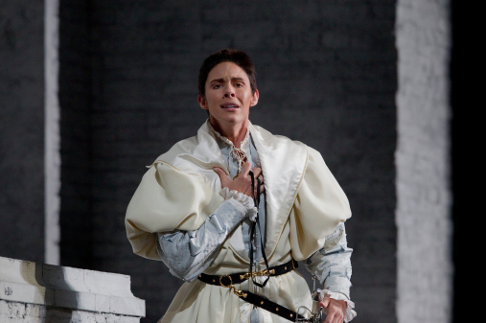 Tamara Mumford as Smeton
Tamara Mumford as Smeton
As a singer, Meade takes a while to warm up. In the first act, she seemed rather to hover over the notes; there was no depth to them, and she seemed merely to touch the highest notes and drop them. By the lengthy duet with Stephen Costello’s Percy, however—Donizetti’s Act II, but the last scene of Act I at the Met, where the opera is given with just one intermission—and the great “Giudici” ensemble that follows, she had her musical feet on the floor. Her duet with Ekaterina Gubanova’s Jane Seymour brought the thrilling days of Sutherland and Horne to mind. As Meade demonstrated in Ernani, she knows how to preserve her resources through a long night. By the long concluding scene, she was in her element, tremendously affecting in the sweet singing of “Al dolce guidami,” and then, with a terrific drop to almost threatening depths that exploded in the anger of “Coppia iniqua,” her final denunciation, a dramatic coloratura at last. The soprano who cannot make this scene her own is not a proper Bolena; Netrebko, too, was fully in charge here.
Gubanova is a Russian mezzo in the grand tradition of Arkhipova and Obastzova, but the Met can’t seem to figure out what to do with her—or such others of the ilk as Diadkova and Smirnova, the latter miscast in Don Carlo. Gubanova is a superb Berlioz Didon (as she has demonstrated at Carnegie Hall under Gergiev) and a superb Gluck Clytemnestre (under Muti in Rome), but she has had some difficulty forcing herself into the molds called for at the Met. To be fair, she only took on the role of Jane Seymour when Elina Garanca, who sang it gorgeously in Vienna, pulled out due to pregnancy, and if her sortita and its ornaments were messy, her duets with King Henry (desperate) and Anna (poignant) had a happy intensity. Her voice mingles well with Meade’s. But I wish they’d stage something Russian for her to sink her palpable artistic teeth into—or Gluck’s Alceste.
Stephen Costello’s once light and liquid tenor is developing grit and strength. This may forfeit some of his airy elegance, but will position him for the forceful tenor roles of later Donizetti, Verdi and Puccini, the basic Italian repertory. He made a handsome, credible figure in the far from credible role of Lord Percy, Anna’s old boyfriend. Slim Tamara Mumford sang another of her plummy performances, with a freer command of line up top than usual, in the trouser role of the importunate minstrel, Smeton. Ildar Abdrazakov was formidable in the somewhat underwritten (no aria) role of King Henry. His dark bass must believably threaten each of the other characters in turn or the plot makes no sense. In the present instance, the quailing of cast and chorus before him was believable. Shaven-headed Keith Miller, such a treat as Zuniga in recent Carmens, was impressive as Anna’s hapless brother, Rochefort.
Marco Armiliato, whose conducting on opening night has been criticized, certainly did not make the score sound shorter than it is, but he was attentive to vocal line and Donizetti’s favorite “British” effect, dark strings underscored by horns, rang out threateningly, gothicly, throughout the night.
John Yohalem
image=http://www.operatoday.com/Bolena_Met_2011_03.png image_description=Angela Meade as Anna Bolena [Photo by Marty Sohl/Metropolitan Opera] product=yes product_title=Gaetano Donizetti: Anna Bolena product_by=Anna Bolena: Angela Meade; Giovanna Seymour: Ekaterina Gubanova; Smeton: Tamara Mumford; Percy: Stephen Costello; Henry VIII: Ildar Abdrazakov. Metropolitan Opera Chorus and Orchestra conducted by Marco Armiliato. Performance of October 24. product_id=Above: Angela Meade as Anna Bolena [Photo by Marty Sohl/Metropolitan Opera]All other photos by Ken Howard/Metropolitan Opera
Castor & Pollux, ENO
Rameau’s operas made a revolutionary impact in their day, giving rise to vehement confrontation between two, warring musical factions at the French court of Louis XV, as the champions of the conservative Lully and controversial Rameau fought for operatic and cultural supremacy.
Yet, Rameau remains relatively rarely performed today, and so anticipation for the first Rameau opera to be presented at ENO was naturally considerable. However, after witnessing director Barrie Kosky’s Castor and Pollux - his company debut and a co-production with Komsiche Opera, Berlin, where Kosky has recently been appointed Intendant — one might have been forgiven for thinking that the opera simply boils down to legs and feet.
Perhaps before I go on, I ought to acknowledge, as I will later expand, that musical standards throughout were high and that some of the production’s eclectic assemblage of motifs, concepts and images were thought-provoking and potentially revealing. But, the absence of ‘particularity’ of time and place ultimately rendered the various symbols rootless and gratuitous. Gestures became gimmicks.
Thus, lower limbs and freakish footwear were visually ubiquitous. Garishly stocking-ed legs; stamping, twisting lower limbs — all that was visible of the chorus as the cavorted behind half-lowered back-drops; the feet of the half-buried Castor protruding from his earthy grave; the disappearing toes of Pollux slipping in pursuit of his brother into the realms of the Underworld; then, the exposed thighs of the sisters, Télaïre and Phébé as they slithered and writhed up and down the earthy burial mound, or, poised above the prostrate Pollux, whipped up their skirts and dragged down their knickers, and another pair, and another pair … If the directorial foot fetish waned, thankfully, after the interval, the chorus’s lower limbs replaced by a row of heads sporting freakish Hallowe’en headgear, the motif was resurrected in the closing scenes of the opera, as twinkling stardust decorated the discarded boots of Castor and Pollux (the brothers now having ascended to immortal realms) — a rather earthbound image for this moment of supreme transcendence.
If such observations seem facetious, I would contend that matters of costume and gesture would matter less if they did not interfere with the music or the drama. Or, if they merely distracted rather than disrupted, even destroyed. For, frequently, Rameau’s vigorous, energised score seemed trampled into submission. Thus, as the introductory instrumental passages initiated the mood and ambience of the conflicts to come, the rhythms and textures succumbed to elephantine clomping, as Laura Tatulescu’s Phébé stomped about the stage like a sulky brat, bewailing her fate and pounding the walls in frustration. This established an irritating precedent. Scarcely an entrance was not accompanied by a fury of footfalls, with the result that the soloists’ poundings often obliterated the precisely nuanced accompaniments to their own and each other’s recitatives — disastrous in a work where every gradation of colour, tempo and harmony underpins a textual or dramatic detail.
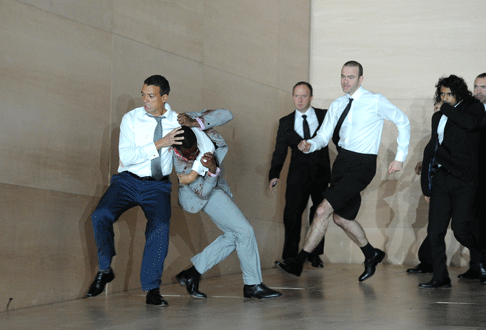 Roderick Williams as Pollux and Omari Bernard as Lyncaeus
Roderick Williams as Pollux and Omari Bernard as Lyncaeus
If the protagonists were not throwing themselves, and each other, noisily about the stage, then the chorus was rushing here and there, frenetic stamping accompanied by demented hand-weaving and wiggling. Seated at times on the very edge of the stage, fore-grounded legs dangling over the orchestral pit, they could not jump up and down, so they bounced inanely on their behinds instead.
Over one half of Rameau’s score is dance music, but in this production the oft changing rhythms and tempi of the orchestral passages, which fluidly interweave between the long recitatives and flexible arioso sections, were overshadowed by such, apparently intentional, cacophonous stage business and clamour. Kosky and conductor Christian Curnyn have left 70% of Rameau’s dances in place, but as the director explains in a programme ‘conversation’, took the decision to have “no dancing in the production. We do other things with the dance music”. There is indeed a medley of such ‘other things’: psychotic jerking about, the now obligatory nudity scenes, some ‘horror’ episodes imported from a B-movie. But, Rameau’s dances are much more than mere divertissements; they elucidate character and plot, and the challenge is to find a way of integrating the dances into the emotional momentum which builds rapidly and frequently to hugely passionate climaxes. (It’s perhaps not inconsequential that the last time a major UK opera company performed Rameau was almost 15 years ago, when American choreographer, Mark Morris staged Platée at Covent Garden.)
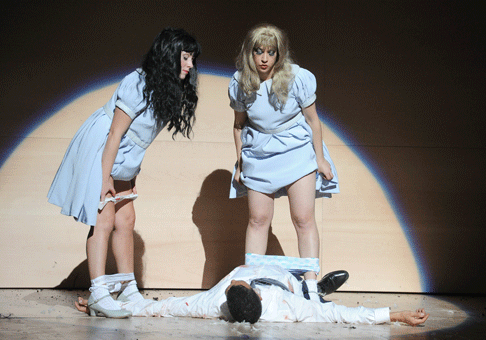 Laura Tatulescu as Phoebe, Roderick Williams as Pollux and Sophie Bevan as Telaïre
Laura Tatulescu as Phoebe, Roderick Williams as Pollux and Sophie Bevan as Telaïre
Designer Katrin Lea Tag’s stage was itself bare and bleak, a harshly lit panelled cube, the only ‘props’ and setting being two plastic folding chairs and a pile of brown earth. Certainly if Lully’s operas were characterised by special effects and spectacle, then his rival Rameau eschewed extravagance in favour of an intense emotional focus. The “timeless”, unspecified locale was designed to concentrate our attention on “the constellation of human emotions of love and jealousy inherent in the piece”, to allow us to focus on the drama; but, I found that the intrusion of an assemblage of random, fantastical, and farcical elements hindered empathy with the protagonists’ essential ethical dilemmas; stripped of its classical restraint and nobility, the opera’s psychological realism was lost.
The question which lies at the centre of the opera is: which is the stronger, fraternal or sexual love? The mortal Castor is brother to Pollux, who is the son of Jupiter and therefore immortal. Both brothers love Télaïre, but although betrothed to Pollux she, like her sister Phébé, adores his earthly sibling. Phébé’s jealous plotting brings about shattering tragedy and loss, but also inspires loyalty, selflessness and love. Following epic trials and travails, the brothers, after several ‘rescue missions’ to dark regions of the after-life, are united in celestial paradise as the constellation Gemini, Castor’s altruism and self-sacrifice leading Jupiter to grant him immortality also. The two women remain alone on earth.
As noted in the programme, in his conversation with Edward Seckerton, Barrie Kosky responded to the suggestion that we “will care about the people in this piece” with an assertion that “You do, which I always find quite difficult”, and this I feel is the heart of the problem with his conception, which focuses overwhelmingly on melancholia, loss and hell as abstract concepts and overlooks the human, and redemptive, dimension of the myth. The problem is clarified when Kosky remarks that he is mystified about the reasons why Jupiter appears for a second time, notes the brothers’ extreme self-sacrifices and rewards them by transporting them to the stars. But this, surely, is the heart of the piece? Nobility of spirit and self-sacrifice underpin the unbreakable bonds between brothers.
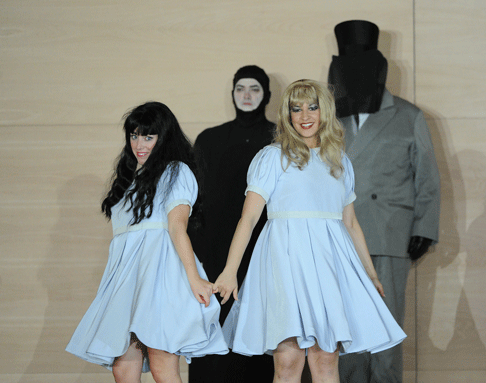 Laura Tatulescu as Phoebe, Sophie Bevan as Telaïre, Andrew Rupp as High Priest of Jupiter and Henry Waddington as Jupiter
Laura Tatulescu as Phoebe, Sophie Bevan as Telaïre, Andrew Rupp as High Priest of Jupiter and Henry Waddington as Jupiter
Such nobility seemed lacking at crucial moments in the production. Thus, when Pollux shows such admirable self-denial in relinquishing Télaïre and endorsing her marriage to his brother, in Kosky’s eyes Castor should demonstrate his appreciation of his sibling’s selflessness by cavorting wildly like an over-excited adolescent. Similarly, when Jupiter shows Pollux — who has agreed to give up his immortality in return for Castor’s freedom — a vision of the heavenly delights which he would enjoy in eternity, Pollux’s unswerving selflessness embodies the essential truth of human, brotherly love. However, here the parade of the pleasures of paradise — the squirming and squealing sisters, pre-pubescent in gingham dresses and white ankle socks — seems more like to send Pollux fleeing rapidly to Hades rather than clutching selfishly at the rewards of immortality.
As is perhaps apparent, much was asked of the singers: they endured on-stage burial, clambered upon precarious mounds, sang principal arias bedecked in Hallowe’en hoods, flung themselves beneath dangerously descending backdrops in a manner which would have impressed 007 himself — and they performed gamely, bravely and at times wondrously, coping well with the particular demands of the French ornamentation.
The heroic journeys undertaken primarily find their equivalent in lengthy musical episodes of recitative, music of great intensity and flexibility, characterised by subtle nuances and troubling contradictions. The rapid changes of tempo, tonality and instrumentation were most pertinently appreciated, and their dramatic meaning conveyed, by Roderick Williams as Pollux. He had no problems with the registral demands of the role, producing sincere gravity at the bottom and vibrant earnestness at top. Dignified throughout, even when dragged violently around the stage by his feet, by the enraged Lyncaeus, Williams’ rich, beautiful baritone conveyed a gamut of emotions from despair and disillusion to happiness and hope.
The role of Castor demands a light, high tenor capable of agile passage work and ringing projection; Allan Clayton proved himself skilled in both regards, as he drew the audience into his tragic journey.
Télaïre has all the best tunes, and Sophie Bevan certainly made the most of them. Her second act aria mourning the death of Castor was spell-binding in its beauty and elegance, and was wonderfully underpinning by expressive playing by the bassoon and flutes.
As Phébé, Laura Tatulescu’s was dramatically compelling, but while her voice is one of power and penetration, her rendition was not always wholly in keeping with the French baroque style. She did not always produce a consistent tone or sustain a long line, which made both musical and dramatic sense, in the extended recitatives.
Ed Lyon was superb in his two minor roles, as the Athlete and Mercury. His vigorous, nimble high tenor eased through the florid passage work; indeed the athleticism of his singing in the former role was in marked contrast to his visual presence as Mercury: for this was a droll Mercury, his wings flapping limply as lamely flopped about — more Eric Morecombe or Mr Bean than soaring servant of the gods.
As Jupiter, Henry Waddington was secure but not as authoritative as he might have been; but then he did spend the entire opera with a black veil masking his face which can’t have helped establish an impression of superhuman majesty. Bass Andrew Rupp demonstrated striking focus as Jupiter’s High Priest, though even he had to battle against his skeletal mask and trailing white fingers (à la Edward Scissorhands?).
The orchestra of ENO, reduced in size, coped admirably with the noisy intrusions from the stage. The instrumentalists were raised up from the deep pit, to enhance balance and clarity, and this afforded a rare view at the Coliseum of the conductor and players. From the first, Curnyn adopted a flexible, muscle style, aiming for springy rhythms. Although in the overture some of the string playing was a little laboured, and the ensemble not always precise, when warmed up the instrumentalists gave an energised reading of Rameau’s robust rhythmic score; by the end, a truly thrilling fleetness characterised the rapid string motifs. Curnyn was ever alert to Rameau’s varied and idiosyncratic instrumental textures, and impressively realised the radical musical architecture of the form, with its fluid movement between recitative, arioso, dance and chorus.
The ENO chorus, having been asked to cavort, giggle, strip and adopt an array of silly costumes, sang with conviction. Occasionally, particularly when huddled in a gaggle at the rear of the stage, they struggled to keep up with the propelling tempi in the pit, but presumably that will improve with familiarity as the run proceeds.
Amanda Holden’s translation was uncontroversial although, in the light of the bare stage platform and other idiosyncratic directorial decisions, there were some non sequiturs. Holden did not quite rise to the challenges presented by long recitatives in eighteenth-century French, and the rhythmic patterns of some phrases was unnatural and awkward; moreover, she often changed syllable on the resolving pitch of rising cadential motifs, which seemed rather clunky and ‘unpoetic’.
Commenting on the effect of his mingling of realism and fantasy, Kosky concludes: “It becomes apparent that we’re actually going nowhere: hell is earth, and earth is hell, and heaven is hell and it’s on earth.” Despite my own misgivings, there was admittedly much applause for the cast and creators at the curtain call (and a few howls too); so my own view may be unrepresentative … but at times it felt as if this production really was going nowhere, and that hell was indeed “here and now”; fortunately some heavenly singing and celestial playing redeemed matters.
Claire Seymour
Click here for video clips and other information regarding this production.
image=http://www.operatoday.com/Castor_ENO_02.gif image_description=Roderick Williams as Pollux, Henry Waddington as Jupiter and Allan Clayton as Castor [Photo by Alastiar Muir courtesy of English National Opera] product=yes product_title=Jean-Philippe Rameau: Castor & Pollux product_by=Castor: Allan Clayton; Pollux: Roderick Williams; Télaïre: Sophie Bevan; Phébé: Laura Tatulescu; Jupiter: Henry Waddington; High Priest of Jupiter: Andrew Rupp; Mercury/Athlete: Ed Lyon. Conductor: Christian Curnyn. Director: Barrie Kosky. Designer: Katrin Lea Tag. Lighting Designer: Franck Evin. English National Opera, London Coliseum, Monday 24th October 2011. product_id=Above: Roderick Williams as Pollux, Henry Waddington as Jupiter and Allan Clayton as CastorPhotos by Alastiar Muir courtesy of English National Opera
